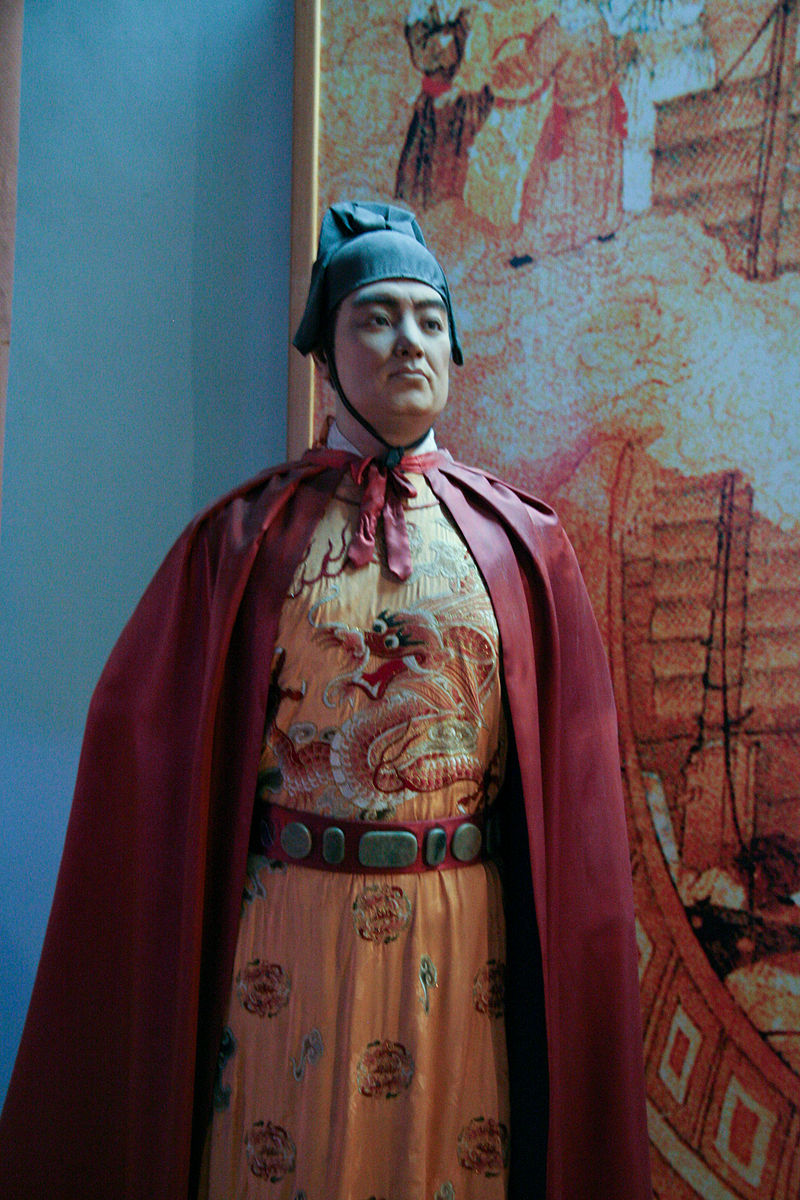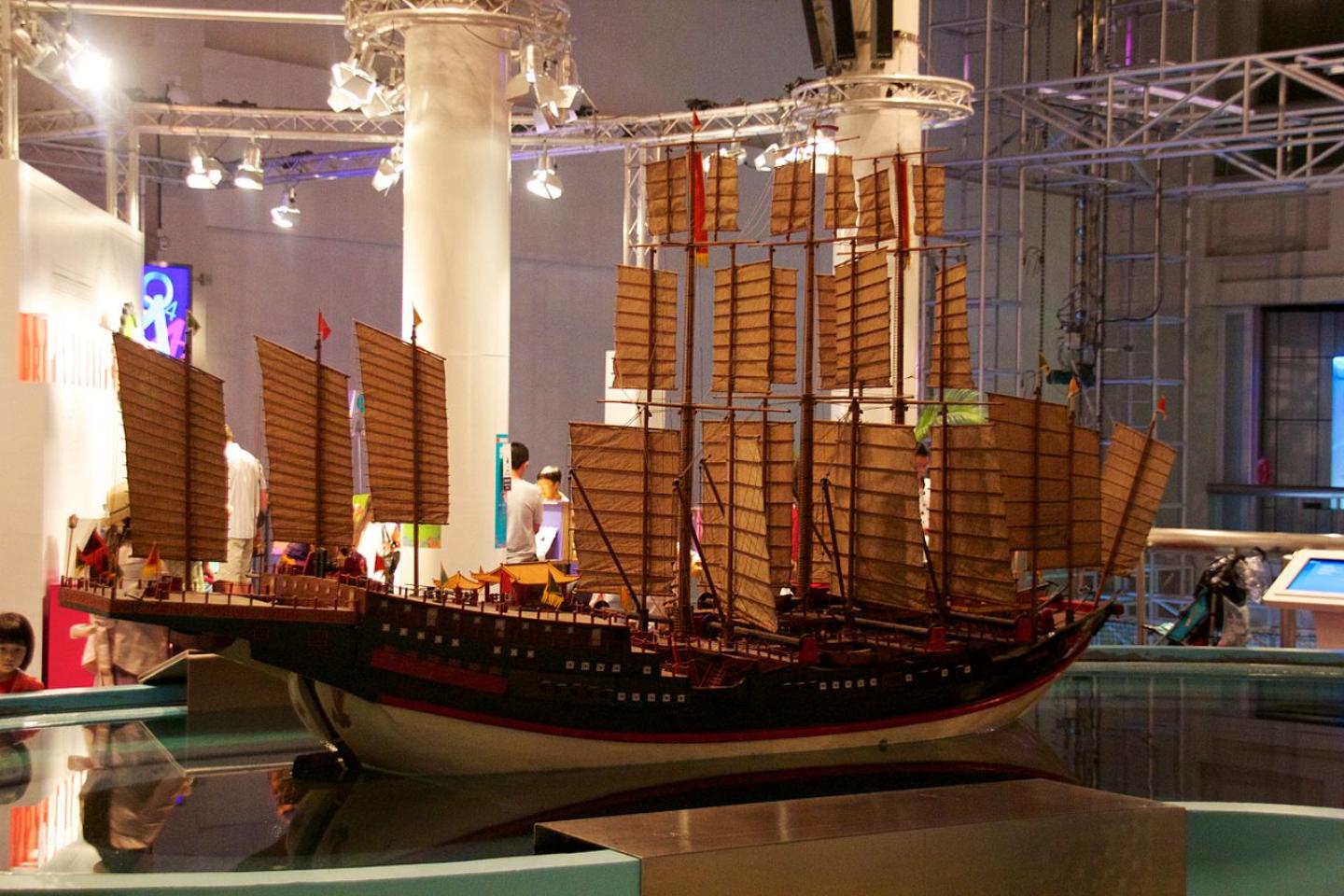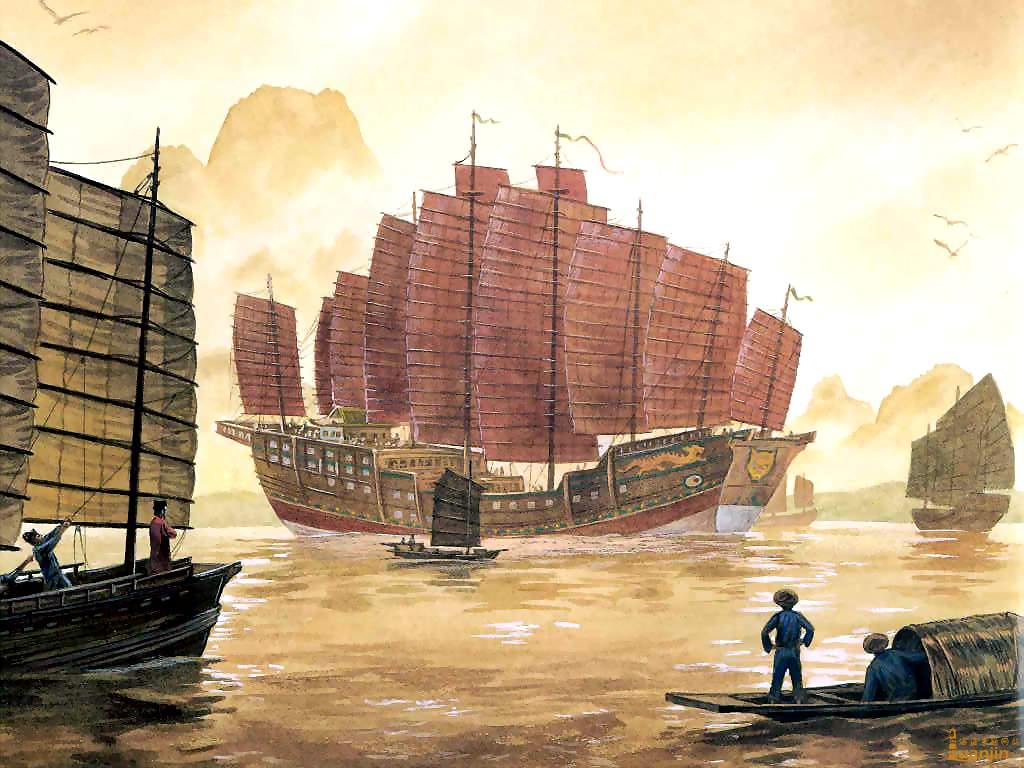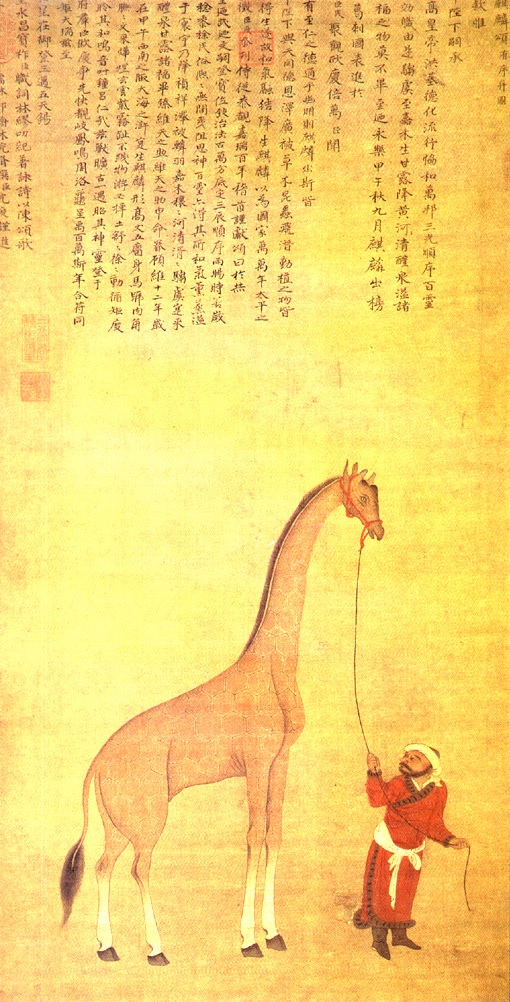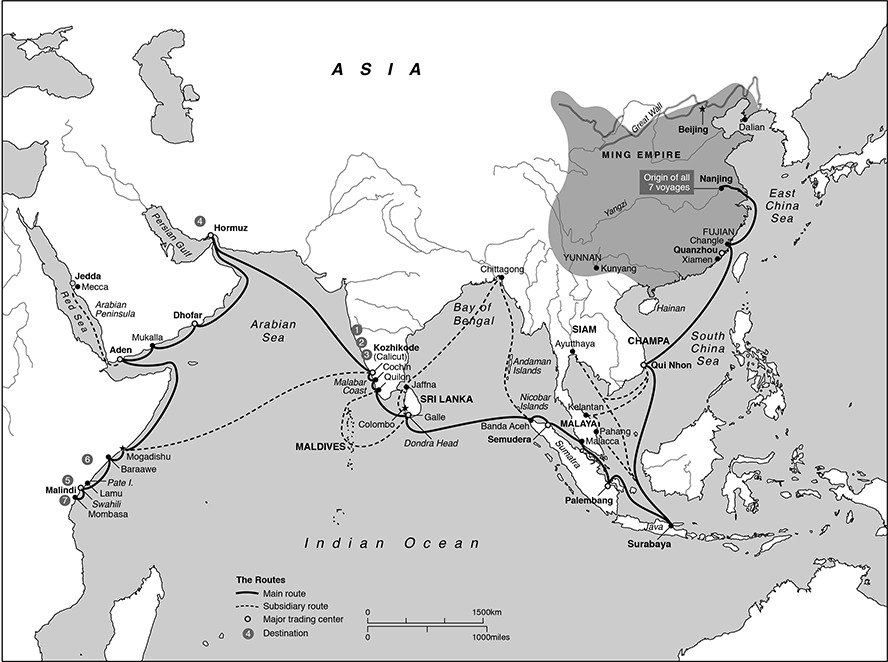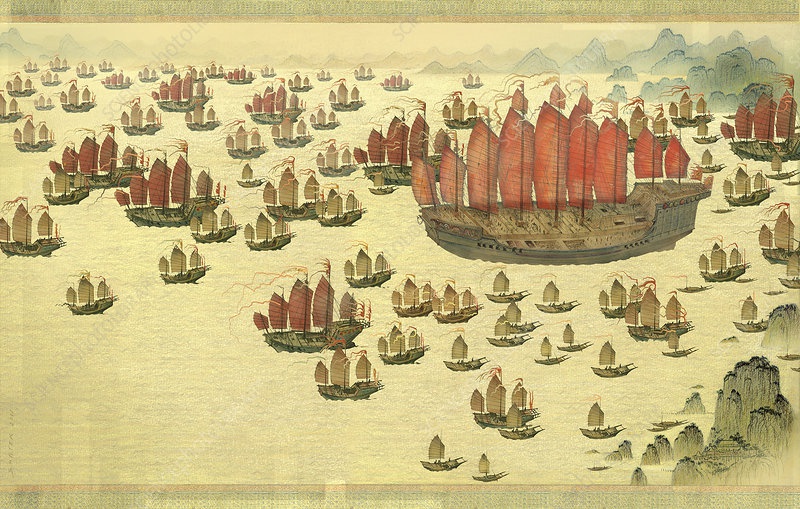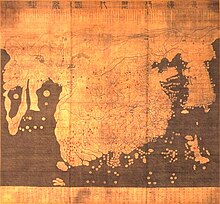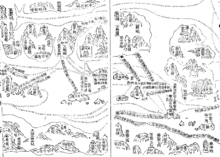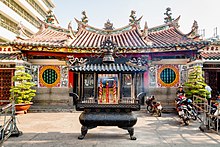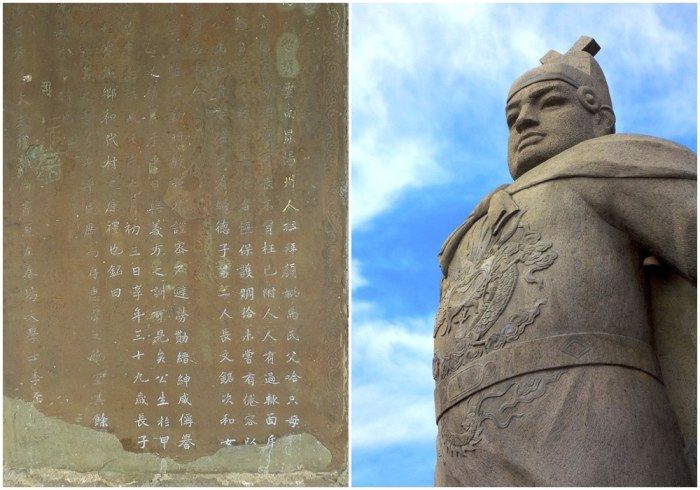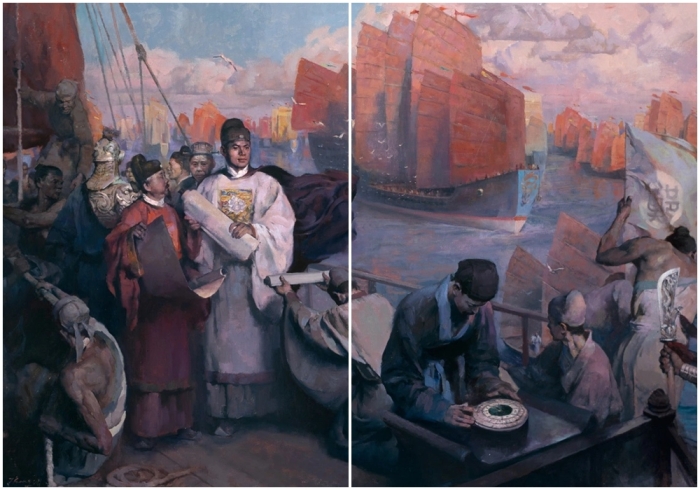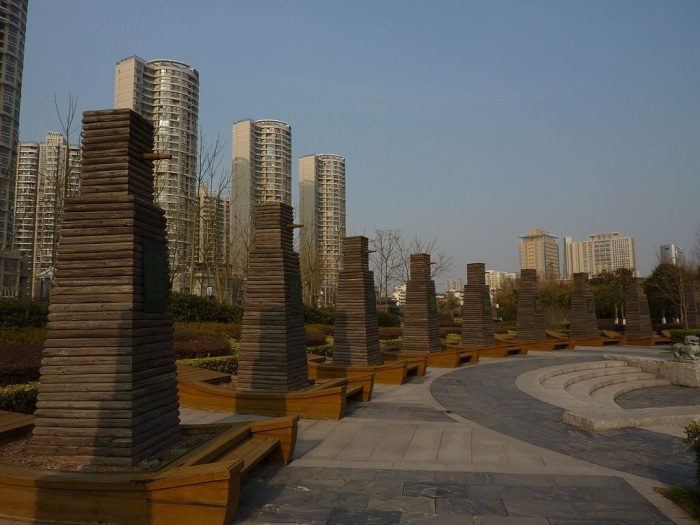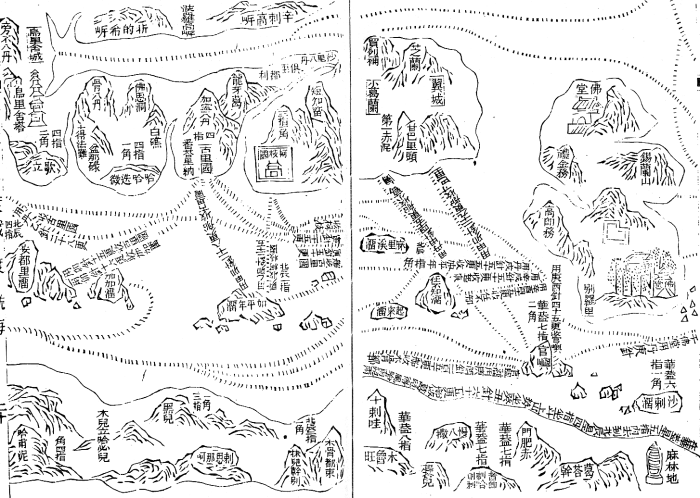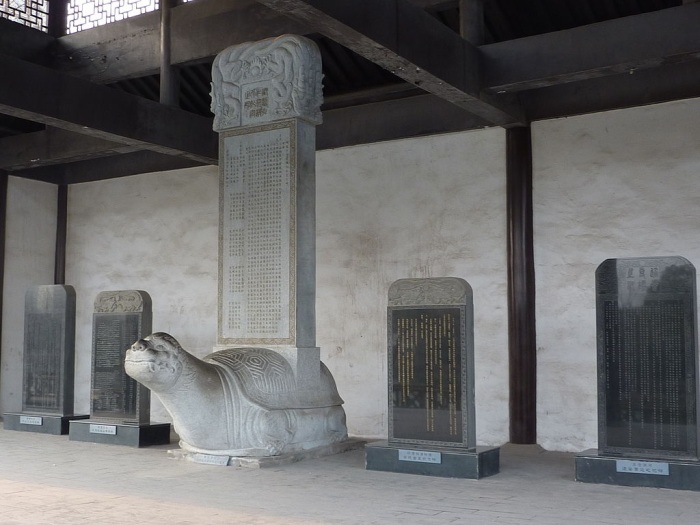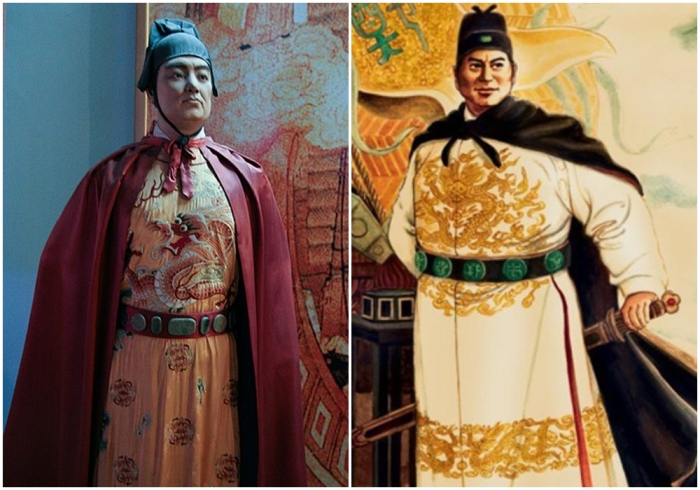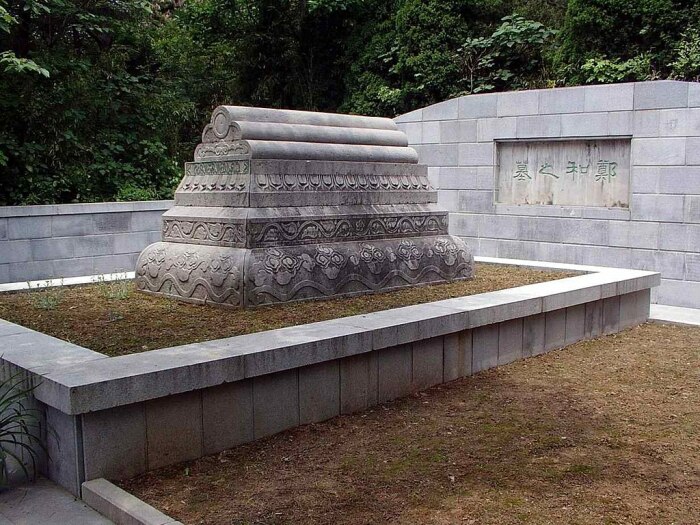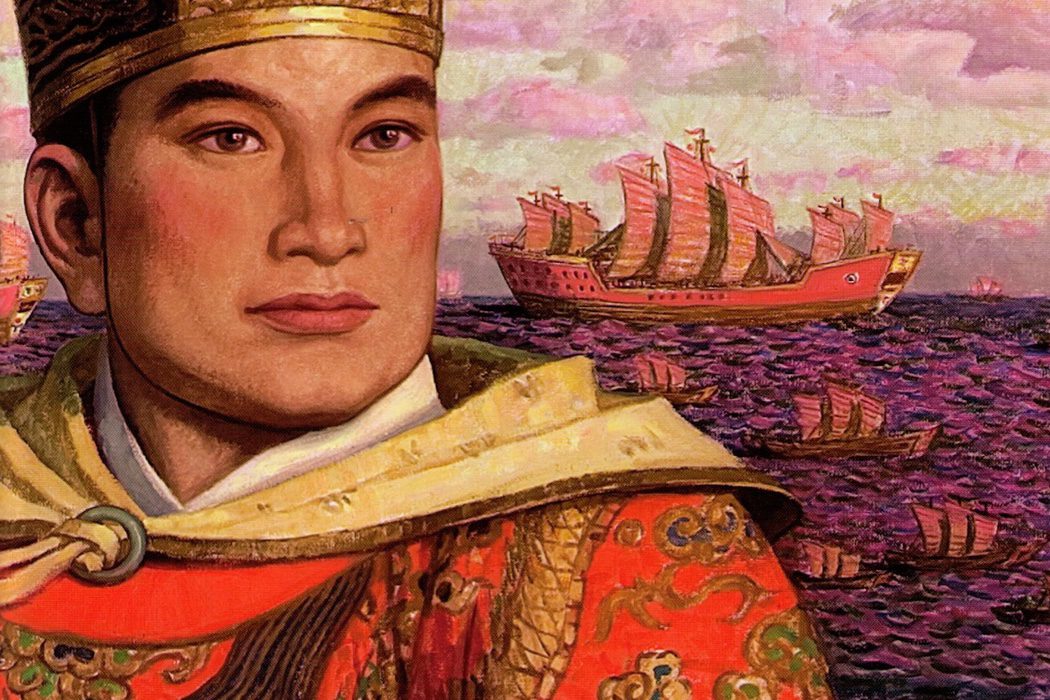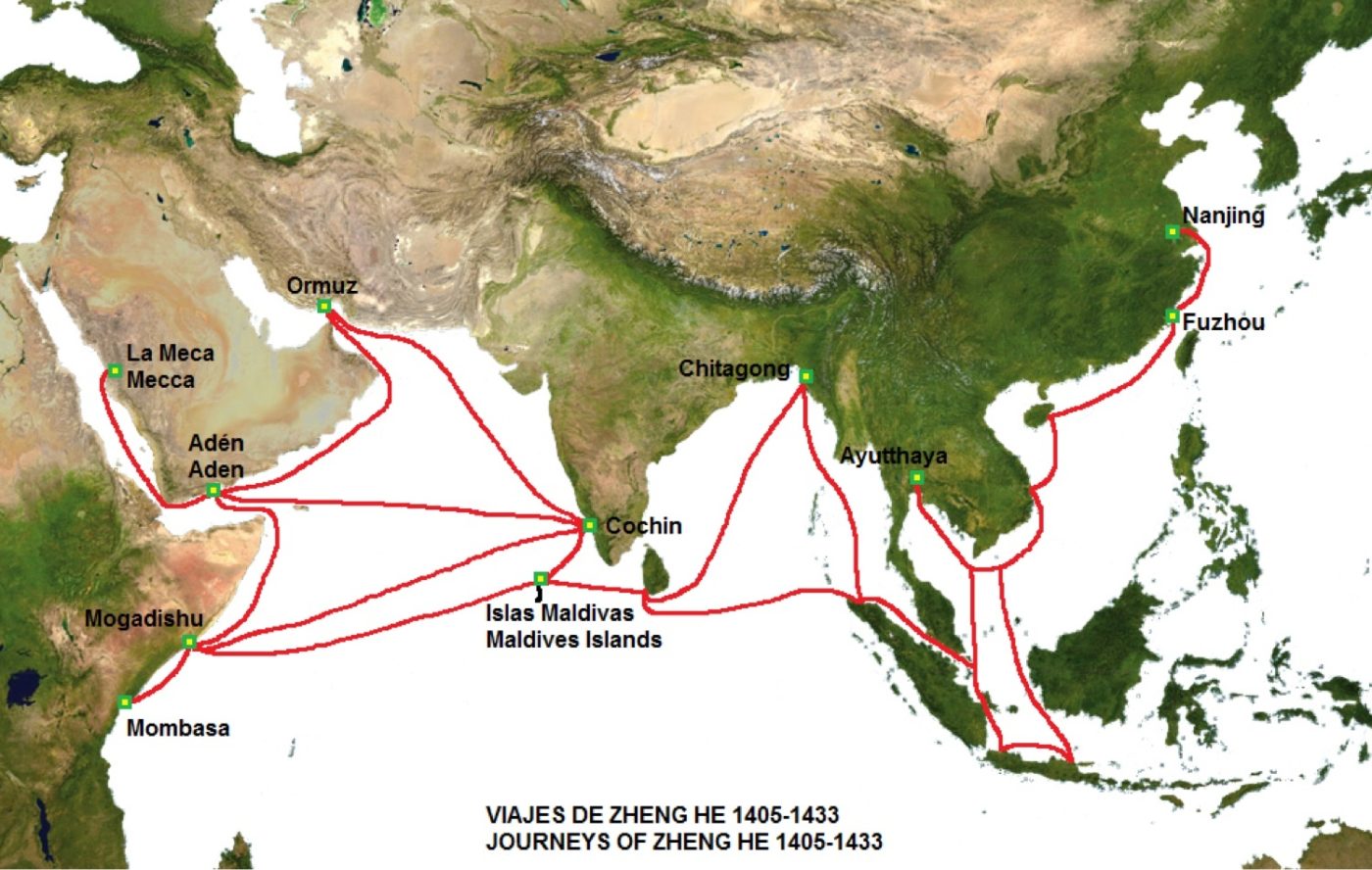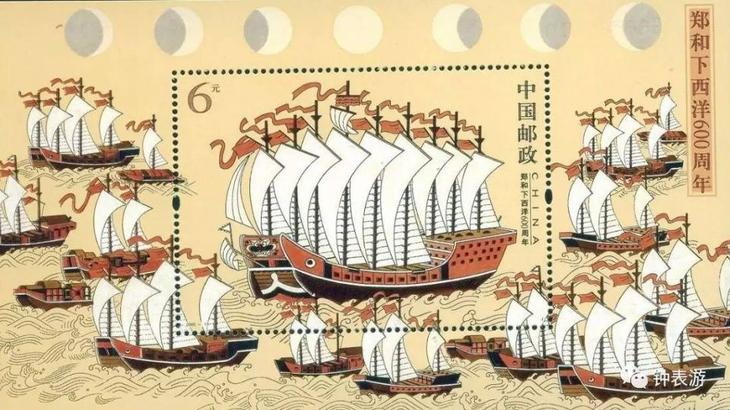Библиографическое описание:
Петров, Р. С. Чжэн Хэ — забытый «Колумб» Поднебесной / Р. С. Петров. — Текст : непосредственный // Исследования молодых ученых : материалы XV Междунар. науч. конф. (г. Казань, декабрь 2020 г.). — Казань : Молодой ученый, 2020. — С. 88-90. — URL: https://moluch.ru/conf/stud/archive/384/16172/ (дата обращения: 22.05.2023).
В статье рассмотрена история экспедиции китайской флотилии под предводительством адмирала Чжэн Хэ, почти на столетие опередившей Великие географические открытия, но сопоставимой с ними по масштабу.
Ключевые слова:
Чжэн Хэ, Китай, экспедиция, мореплаватель, путешествие, флотилия, адмирал, династия Мин, флот.
Сегодня практически все знают об известном мореплавателе Христофоре Колумбе, о тех открытиях, которые он сделал во время своих путешествий. Между тем, мало кому известно имя адмирала Чжэн Хэ, который возглавлял огромную флотилию Китайской империи во времена правления Сына Неба Чэн-цзу.
Фигура Чжэн Хэ и его путешествия привлекают внимание исследователей потому, что они стали важным моментом в истории империи Мин. Благодаря этим походам, империя значительно расширила свое влияние в Индии, Персидском заливе и даже на Африканском континенте. Кроме того, это были первые в мировой истории морские исследования такого масштаба, которые более чем на 70 лет опередили эпоху Великих географических открытий на Европейском континенте.
Весьма спорным является вопрос, о причинах, заставивших императора Чэн-цзу снарядить эту военно-морскую экспедицию и создать огромный по своим масштабам флот. Исследователи выдвигали различные версии относительно целей, которые были поставлены перед флотилией. По мнению некоторых, Чжэн Хэ являлся первопроходцем как Кук или Колумб. Другие утверждают, что целью экспедиций был поиск будущих колоний для Империи, свидетельством чему являются размеры флотилии. Третьи рассматривают морские походы Чжэн Хэ как торговые предприятия, а хорошо вооруженные корабли с большим количеством солдат призваны были обеспечить военное прикрытие на случай возникновения неприятностей. Противники последней версии, не соглашаясь с ней, отмечают, что к тому моменту, как флот Чжэн Хэ отправился в путь, Китай вел достаточно оживленную торговлю с Индией, Индокитаем, Японией, Корейским полуостровом и Аравией. Таким образом, развитие торговых связей не могло быть основанием для похода. Помимо этого, жители Китая достаточно свободно расселялись на соседних территориях, создавали там свои диаспоры, а потому создавать колонии не было необходимости.
Известный же российский китаевед А. Бокшанин в своем труде «Китай и страны Южный морей» высказал предположение о том, что целью путешествия был поиск союзников для оказания отпора монгольскому хану Тамерлану, поскольку в эпоху Мин отношения между монголами и Китаем были достаточно напряженными [2, c. 94]. Однако, по мнению ряда исследователей, данная версия является несостоятельной. Дело в том, что к моменту организации похода наблюдается спад напряженности. Кроме того, сам Тамерлан умер в 1405 г., в тот год, когда корабли армады Чжэн Хэ тронулись в путь.
Сегодня многие историки сходятся во мнении о том, что целью экспедиции было получение признания со стороны соседних государств молодой династии Мин в лице Чэн-цзу, поскольку последний взошел на трон, отобрав это право у своего племянника Чжу Юньвэня. Необходимость в признании была обусловлена распространяющимися слухами о том, что Чжу Юньвэня выжил во время пожара во дворце. Он сбежал, скрылся за пределами Китая и был занят поиском союзников, для того чтобы вернуть принадлежащий ему по праву трон. Таким образом, отправляя в плавание внушительных размеров флот, император рассчитывал, что продемонстрирует своим соседям мощь Поднебесной, и если слухи все-таки верны, и его племянник жив, то у него не получится найти себе союзников.
Однако это была не единственная цель экспедиции. Поход должен был способствовать оживлению торговых связей Китая с соседями, которая пошла на спад в ходе политики самоизоляции, проводимой предшественником Чэн-цзу. Видел император в этой экспедиции и возможность пополнить свою казну, поскольку внешняя торговля сулила немалую прибыль, а сухопутные пути стали небезопасны, а некоторые из них вообще недоступны в результате нашествия монголов.
По приказу Чэн-цзу была создана целая флотилия, которая включала порядка 300 кораблей. Согласно археологическими данными, некоторые из этих кораблей в длину могли достигать 138 метров, а в ширину — 55. Размеры же флагманского корабля были еще более внушительными. Это был девятимачтовый корабль длиной в 150 м. К примеру, судно, на котором Христофор Колумб отправился бороздить океанские просторы, в длину достигало 30 м., а в ширину — 8. Это притом, что построено оно было спустя 70 лет. [1, с. 130]
Первая экспедиция, согласно данным, зафиксированным в хронике «Тай-цзуна», отправилась в путь 11 июля 1405 г. В путь отправились 255 дожонок, которые вмещали более 27 тыс. человек. Возглавил экспедицию сановник императора, евнух по имени Чжэн Хэ.
Чжэн Хэ (Мань Санбхо), родившийся в 1371 г. в провинции Юньнань, в возрасте 13 лет был захвачен в плен армией императора. В силу того, что по происхождению мальчик являлся представителем рода Юань монгольской династии, которая возглавляла провинцию Юньнань в XIII веке, его подвергли процедуре оскопления и сделали евнухом при императорском дворе. Постепенно он стал доверенным лицом императора Чэн-цзу, а позже возглавил «золотой императорский флот».
Под предводительством адмирала Чжэн Хэ было совершено целых семь морских экспедиций, которые проходили в период с 1405 по 1435 годы. Все морские походы адмирала начинались с вод Южно-Китайского моря. Далее корабли переплывали Индийский океан, двигаясь в направлении Цейлона и южного Индостана.
Во время первой экспедиции китайские мореплаватели посетили государство Тямпа. Это одно из двух государств, образованных на территории современного Вьетнама. Тямпа и Дайвьет находились в состоянии постоянной конфронтации, одновременно Дайвьет враждовал с Китайской империей. Во время посещения Тямпы Чжэн Хэ смог достичь соглашения о союзе против Дайвьета.
Следующими на пути флотилии Чжэн Хэ были Ява и султанат Палембанг, расположенный на Суматре. Далее флот двинулся к берегам Южной Индии. Миновав Бенгальский залив, мореплаватели добрались до Цейлона, а оттуда их путь лежал в город-государство Каликут. Прибывшая сюда китайская флотилия была благосклонно встречена местным правителем, который покровительствовал развитию морской торговли. Китайским мореплавателям удалось не только продать весь товар, бывший у них на кораблях, но и купить здесь разнообразные товары, которые они и доставили домой.
Первый поход Чжэн Хэ нельзя назвать полностью спокойным. Дело в том, что по дороге домой его флотилия встретилась с пиратами, которых возглавлял Чэнь Цзуи. Между ними завязался бой, Чжэн Хэ не только вышел из него победителем, но и захватила Чэнь Цзуи в плен, последний был казнен в Нанкине.
Одновременно с флотилией в Китайскую империю прибыли посланники из различных государств: Малакки, Суматры, Килона, Калитута и др., которые засвидетельствовали правителю Поднебесной свое почтение и преподнесли ему богатые дары.
Вторая экспедиция отправилась в путь где-то в конце 1407 — начале 1408 гг. Корабли должны были доставить иностранных посланников на родину, в связи с этим маршрут второго похода был идентичен первому. Экспедиция носила чисто политический характер. При поддержке китайских посланников в Каликуте был избран новый правитель Мана Вирканам. Также они вмешались в конфликт между кхмерами и сиамцами. Вернулась флотилия в Китай в 1408 г.
Новый, третий по счету, поход начался уже на следующий год. Согласно историческим источникам, в путь отправилось только 48 судов. Курс пролегал через Тямпу, Темасек (сегодня это Сингапур) в Малакку, где Чжэн Хэ подтвердил признание суверенитета султаната Парамешвара Китайской империей и, соответственно, гарантировал поддержку его власти здесь. Далее армада двинулась в султанат Самудра-Пасай, а оттуда на Шри-Ланку. Подтверждением того, что китайские мореплаватели посетили Шри-Ланку, является обнаруженная археологами в 1911 г. стела близ города Галле. Здесь, хоть и не сразу, китайцам также удалось утвердить свое влияние. Заглянул флот Чжэн Хэ в Килон, Кочин и Каликут, а в 1411 г. прибыл в Нанкин.
Первые три экспедиции позволили Китаю не только наладить торговые отношения, но и получить признание в качестве сюзерена со стороны многих государств южной Индии и юго-восточной Азии. В связи с этим, стратегическим направлением четвертого (1413–1415 гг.), пятого (1416–1419 гг.) и шестого (20-е годы XV в.) походов стали Персидский залив, Аравия и Африка. Несмотря на то, что эти территории были знакомы китайцам, но систематического их изучения не проводилось. Флот, состоящий из 63 судов и более чем 28 тыс. человек, отправился в путь в 1413 г. Экспедиция продлилась два года.
Во время своих плаваний китайским мореплавателям удалось посетить примерно около полусотни стран, по отдельным данным их число достигает 60. Исследователи составляли не только подробные карты своих путешествий (это позволяет предполагать, что эти карты были использованы европейцами в эпоху Великих географических открытий), но и описывали города, которые посетили (политическое устройство, климатические условия, местные обычаи и традиции, и даже легенды).
Приемник Чэн-цзу, Сюань-цзу во многом продолжал начинания своего деда. Он покровительствовал наукам, помогал своим подданным, которые пострадали в результате стихийных бедствий, снижая налоги, вел борьбу с коррупцией. А в начале 1432 года снарядил новую, седьмую, морскую экспедицию, которую, как и предыдущие шесть, было поручено возглавить Чжэн Хэ. Во время экспедиции планировалось обновить взаимоотношения с государствами, которые платили дань в казну императора Поднебесной, установить здесь мир и спокойствие, а также расширить свое влияние дальше, добравшись до Аравийского полуострова и северо-восточной Африки. Поставленные цели были достигнуты. Флотилия Чжэн Хэ, начав свое путешествие традиционно в водах Южно-Китайского моря, не только преодолела свой традиционный путь, но и достигла берегов Персидского залива, побывала в Красном море и достигла побережья восточной Африки, где побывала в Могадишо (город, который на сегодняшний день является столицей Сомали). По некоторым данным, флотилия смогла достичь Занзибара, китайские мореплаватели смогли посетить Малиндию (территория современной Кении). Однако во время похода императорский адмирал умер [3, c. 118].
Между тем, ситуация в стране коренным образом изменилась. К моменту возвращения флота на родину умирает император Сюань-цзу. Его старший сын Ин-цзун, взошедший на престол в шестилетнем возрасте, полностью попал под влияние своего учителя-евнуха, который практически управлял государством. Во время правления Ин-цзуна частым явлением становятся восстания (подданные были недовольны налоговым бременем и обязанностью участвовать в принудительных строительных работах), усугубилась ситуация и тем, что, начиная с 1435 г., отдельные регионы Китайской империи страдали от засухи. Весьма напряженной оказалась и внешняя обстановка: обострилась внешняя угроза со стороны монголов, была начата война против бирманского племени, требовавшая колоссальных денежных затрат. В этих условиях императоры Поднебесной не просто вынуждены были отказаться от новых морских компаний, но и забыли на достаточно продолжительное время о морских экспедициях под руководством Чжэн Хэ. Только хроники династии Мин сохранили данные о них [4].
Путешествия Чжэн Хэ стали значительной вехой в истории Китая. Они способствовали экономическому и культурному развитию страны, поскольку Чжэн Хэ во время своих походов не только налаживал торговые связи и устанавливал дипломатические отношения с соседями, но и возвращался на родину с трюмами, полными дани, а также подробнейшим образом фиксировал всю информацию о странах, в которых побывал.
Литература:
- Андрей Булгак Великие тайны и загадки от древнейших времён до наших дней / Булгак Андрей. — Тверь: Белфакс, 2008. — 263 c. — Текст: непосредственный.
- Волков А. Семь плаваний адмирала Чжэн Хэ //Исторический журнал. — 2014. — №. 10.
- Кравчевский И. В. Путешествия адмирала Чжэн Хэ (1405–1433) //Студенческое сообщество и современная наука. — 2019. — С. 114–119.
- Шисыр И. С. Предания о знаменитых исторических деятелях Китая: Чжэн Хэ //Научная дискуссия: вопросы филологии, искусствоведения и культурологии. — 2016. — №. 4. — С. 103–108.
«Золотой флот» Чжэн Хэ выходит в море
В 1405 — 1433 гг. китайцы совершили семь экспедиций по Тихому и Индийскому океанам. Корабли Поднебесной добрались до Индии и восточного побережья Африки намного раньше, чем это сделал Васко да Гама. Достигли китайцы и Красного моря, откуда совсем немного оставалось до Европы. Китай, в ту пору несомненно более развитый технически и экономически, чем страны Запада, стоял на пороге великого прорыва и цивилизационной экспансии.
Все эти плавания возглавлял адмирал Чжэн Хэ. Этот внушительный человек двухметрового роста, крепкий и строгий, когда-то был всего лишь придворным евнухом. Его таланты, храбрость и ум помогли ему сделать военную карьеру в походах на границах империи и в борьбе за власть своего господина, Чэн-цзу (он же Чжу-ди). Этот император придавал большое значение наукам и внешней торговле. При нём свершился подъём китайской культуры. Чэн-цзу желал проложить удобные морские маршруты и отправить во все страны свои миссии с предложением взаимовыгодного обмена товарами, а заодно — найти потенциальных союзников.
Чжэн Хэ, который давно заслужил доверие императора, выполнил эту задачу. Адмирал проложил маршруты Китай — Индия (он же Южноазиатский морской путь), а затем и Китай — Африка с остановками в бухтах Вьетнама, Явы, Суматры, Цейлона, Таиланда, Индии, Ирана и Аравии, избавил этот путь от пиратов, картографировал берега южных морей и составил лоции, развил торговые связи, основал на Суматре, Яве и в других местах китайские колонии и опорные пункты.
Адмирал Чжэн Хэ, современная статуя. (en.wikipedia.org)
Отличительной особенностью китайских плаваний был их размах. Это европейцы в Новое время переплывали океаны на паре судёнышек с командой в пару сотен человек, как, к примеру, Джеймс Кук; даже великий Христофор Колумб открыл Америку всего на трёх небольших судах и с сотней моряков. А китайский флот — это колосс. Кораблестроение и мореплавание в Китае к излёту Средних веков стояли очень высоко. Уже в XIII веке китайцы могли произвести за месяц сотню кораблей. Огромные флоты, построенные в дельте Янцзы и на реке Люцзяхэ, использовались для походов на Яву и в Японию, а также для торговли зерном. Когда итальянский путешественник Одорико Порденоне посетил Гуанчжоу, он поразился: «…кораблей здесь столько и так велики они, что просто глазам не веришь. Право же, во всей Италии нет такого множества кораблей, как в этом одном только городе». И это писал человек, на родине которого (родине Колумба!) так славились венецианские и генуэзские мореходы! Но в ту пору до китайцев им было далеко.
Первую экспедицию Чжэн Хэ подготовил к 1405 г. Поистине это был самый грандиозный флот в истории — 62 военных и грузовых корабля и 27 800 человек! Эти суда были огромны; самые большие, которые называли «кораблями сокровищ» — до 140 метров в длину (как четыре девятиэтажных дома) и 58 метров в ширину, на них стояло до 14 мачт с тростниковыми парусами, вёслами орудовали сотни гребцов, а команда располагалась в десятках кают. Корабли до 108 м в длину считались средними. По сравнению с этим колумбова каравелла «Санта-Мария» примерно 23 м длиной (по другим данным — до 19 м) — жалкая шлюпка.
Примечание: Существует предположение, что кораблей в экспедиции участвовало более 200, а фигурирующая в источниках цифра 62 относится лишь к крупным парусникам, «сокровищницам»; предположение основано на том, что перед плаванием Чжэн Хэ китайский император заказал на верфях ещё около двухсот обычных кораблей. Источники не позволяют в полной мере подтвердить или опровергнуть эту гипотезу и подсчитать точную численность всей армады.
Корабли Чжэн Хэ. (bangkrod.blogspot.com)
Семь плаваний за сто тысяч ли
Первая экспедиция посетила Яву, Суматру, Цейлон и Индию, где торговали множеством ценных товаров. Один из хронистов Чжэн Хэ, Ма Хаунь, перечислял их: «Перец, розовое масло, жемчуг, ладан, амбра, кораллы, цветные хлопчатые ткани, и всё это вывозится из других стран (…) и покупают здесь золото, серебро, хлопчатые ткани, голубой и белый фарфор, бусы, ртуть, камфару, мускус, и есть тут большие склады (…) и сюда привозят чудесных коней из западных стран, и стоят они сотни и тысячи золотых монет». За всем этим в Индию стремились позже и европейцы. В Каликуте, где китайцев приняли особенно хорошо, Чжэн Хэ установил памятный знак: «Пришли из Китая, отстоящего на сто с лишним тысяч ли. Повидали все народы и познали многое и разное. Пусть же земля и небо будут благосклонны к нам».
В 1407 г. флот Чжэн Хэ возвратился из первого плавания с трюмами, полными богатого груза. Выполнил он и дипломатическую миссию, привёз послов. Император, представитель молодой Минской династии, получил признание и дружбу соседей. Китай наладил связи с несколькими царствами и получил безопасный путь в Индию. Сразу же после этого Чжэн Хэ отправился во второе путешествие — чтобы повторить успех. В каждом следующем плавании флотоводец расширял границы китайской торговли, открывал новые гавани и народы. В ходе пятого плавания, в 1418 году, Чжэн Хэ первым из китайцев добрался до Африки, где в обмен на китайские шёлк и фарфор получил львов, леопардов, зебру, коней, верблюдов, страусов и других диковинных животных.
Последнее плавание Чжэн Хэ (в тот раз китайцы добрались до Сомали) завершилось летом 1433 г. Все суда его флота вернулись в Нанкин.
Изображение жирафа, привезённого из Бенгалии. Китай, XV в. (ru.wikipedia.org)
Маршруты Чжэн Хэ. (oxfordre.com)
Упущенный шанс
К сожалению для прогресса и Китая, плавания Чжэн Хэ не переросли в череду экспедиций других мореплавателей и новых грандиозных открытий, как на Западе. Возможно, путешествия китайской армады продолжились бы, если бы не преклонный возраст и кончина адмирала. По одной версии, он умер ещё по пути домой, на корабле, по другой — вскоре по возвращении. Так или иначе, у мореплавателя не нашлось преемников. В Европе множество людей бросились вслед за Васко да Гамой и Колумбом — открывать новые земли, в Китае — нет. Главная причина — благополучие китайской знати. Аристократы обладали несметными богатствами у себя дома, ничто не стимулировало их снаряжать безумно дорогие и опасные экспедиции, когда главные торговые пути и партнёры и так уже, казалось, известны.
Чэн-цзу, который продвигал своего адмирала и его дело вопреки воле подданных (оплачивавших «Золотой флот»), скончался ещё в 1424 г. Лишь слава и влияние Чжэн Хэ позволяли ему продолжать плавания. Но после его смерти у китайского флота не осталось идейных вдохновителей. Новый император, ещё очень юный и легко поддававшийся влиянию, решил «приостановить посылку кораблей в Западное море за диковинными и драгоценными товарами», а затем и выслать из Пекина послов 11 стран: «Не надо утомлять Китай заботами о людях из далёких стран». Монарх следовал за голосами тех, кто находил плавания адмирала Хэ слишком обременительными для казны. Это было правдой — не зря флот Чжэн Хэ называли «Золотым». И надо признать, для экономии казённых денег имелись объективные причины — засухи, восстания внутри Китая, разорительные войны с монголами. Потенциальная прибыль от заморских экспедиций казалась слишком неочевидной. К чему эти иностранцы с их жирафами и кокосами, когда всё необходимое производится дома? Зачем тратить столько денег на заморские диковинки, когда есть более насущные дела? Никто не задумывался о колонизации далёких земель.
«Золотой флот». (fr.quora.com)
В XV веке Китай мог колонизировать другие континенты
С 1430-х гг. Китай постепенно замыкался в себе. О путешествиях Чжэн Хэ постарались забыть как о блажи странного императора и его приближённого. «Золотой флот» сгнил в доках. Кто мог тогда представить, что это роковая ошибка и что за несколько столетий замкнутость Китая приведёт к деградации страны, её отставанию и, в конечном счёте, к подчинению Европе. Шанс XV века был упущен.
|
Zheng He |
|
|---|---|
|
鄭和 |
|

Statue from a modern monument to Zheng He at the Stadthuys Museum in Malacca City, Malaysia |
|
| Born |
Ma He 1371[1] Kunming, Yunnan, Yuan (Prince of Liang) |
| Died | 1433 (aged 61–62) or 1435 (aged 63–64) |
| Other names | Ma He Ma Sanbao Cheng Ho |
| Occupations | Admiral, diplomat, explorer, and palace eunuch |
| Era | Ming dynasty |
| Zheng He | |||||||||||||||||||||||||
|---|---|---|---|---|---|---|---|---|---|---|---|---|---|---|---|---|---|---|---|---|---|---|---|---|---|

Zheng’s name in Traditional (top) and Simplified (bottom) Chinese characters |
|||||||||||||||||||||||||
| Traditional Chinese | 鄭和 | ||||||||||||||||||||||||
| Simplified Chinese | 郑和 | ||||||||||||||||||||||||
|
Zheng He (simplified Chinese: 郑和; traditional Chinese: 鄭和; pinyin: Zhènghé; Wade–Giles: Chêng-ho; 1371–1433 or 1435) was a Chinese mariner, explorer, diplomat, fleet admiral, and court eunuch during China’s early Ming dynasty, and often regarded as the greatest sailor in Chinese History. He was originally born as Ma He in a Muslim family and later adopted the surname Zheng conferred by the Yongle Emperor.[2] Commissioned by the Yongle Emperor and later the Xuande Emperor, Zheng commanded seven expeditionary treasure voyages to Southeast Asia, South Asia, West Asia, and East Africa from 1405 to 1433. According to legend, his larger ships carried hundreds of sailors on four decks and were almost twice as long as any wooden ship ever recorded.
As a favorite of the Yongle Emperor, whom Zheng assisted in the overthrow of the Jianwen Emperor, he rose to the top of the imperial hierarchy and served as commander of the southern capital Nanjing.
Early life and family[edit]
Zheng He was born Ma He (馬和) to a Muslim family of Kunyang, Kunming, Yunnan, during the Ming dynasty of China.[3] He had an older brother and four sisters.[4]
Zheng He’s religious beliefs were eclectic in his adulthood.[5] The Liujiagang and Changle inscriptions suggest that devotion to Tianfei, the patron goddess of sailors and seafarers, was the dominant faith to which he adhered, reflecting the goddess’s central role to the treasure fleet.[6] John Guy mentions, «When Zheng He, the Muslim eunuch leader of the great expeditions to the ‘Western Ocean’ (Indian Ocean) in the early fifteenth century, embarked on his voyages, it was from the Divine Woman that he sought protection, as well as at the tombs of the Muslim saints on Lingshan Hill, above the city of Quanzhou.»[7]
Zheng He was a great-great-great-grandson of Sayyid Ajjal Shams al-Din Omar, who served in the administration of the Mongol Empire and was the governor of Yunnan during the early Yuan dynasty.[8][9] His great-grandfather Bayan may have been stationed at a Mongol garrison in Yunnan.[10] Zheng He’s grandfather carried the title hajji,[11] and his father had the sinicized surname Ma and the title hajji, which suggests that they had made the pilgrimage to Mecca.[12]
In the autumn of 1381, a Ming army invaded and conquered Yunnan, which was then ruled by the Mongol prince Basalawarmi, Prince of Liang.[13] In 1381, Ma Hajji, Zheng He’s father, died in the fighting between the Ming armies and Mongol forces.[14] Dreyer states that Zheng He’s father died at 39 while he resisted the Ming conquest, while Levathes states that Zheng He’s father died at 37, but it is unclear if he was helping the Mongol Army or was just caught in the onslaught of battle.[13][14] Wenming, the oldest son, buried their father outside Kunming.[14] In his capacity as Admiral, Zheng He had an epitaph engraved in honour of his father, composed by the Minister of Rites Li Zhigang on the Duanwu Festival of the third year in the Yongle era (1 June 1405).[15]
Capture, castration and service[edit]
Zheng He was captured by the Ming armies at Yunnan in 1381.[14] General Fu Youde saw Ma He on a road and approached him to inquire about the location of the Mongol pretender. Ma He responded defiantly by saying that the Mongol pretender had jumped into a lake. Afterwards, the general took him prisoner.[16] He was castrated at some point between the age of 10 and 14,[16][17] and was placed in the service of the Prince of Yan.[17]
Ma He was sent to serve in the household of Zhu Di, the Prince of Yan, who later became the Yongle Emperor.[18] Zhu Di was eleven years older than Ma.[19] Enslaved as a eunuch servant, Ma He eventually gained the confidence of Zhu Di, who, as his benefactor, would gain the allegiance and loyalty of the young eunuch.[20] Since 1380, the prince had been governing Beiping (later Beijing),[13] which was near the northern frontier, with hostile Mongol tribes.[21] Ma would spend his early life as a soldier on the northern frontier.[22] He often participated in Zhu Di’s military campaigns against the Mongols.[23] On 2 March 1390, Ma accompanied the Prince when he commanded his first expedition, which was a great victory, as the Mongol commander Naghachu surrendered as soon as he realized he had fallen for a deception.[24]
Ma Hajji, a Yuan Dynasty official in Yunnan (a descendant of Sayyid Ajjal Shams al-Din Omar), and his young son Ma He, the future Admiral Zheng He, as imagined by a modern Kunyang sculptor.
Eventually, he gained the confidence and trust of the prince.[19] Ma was also known as «Sanbao» during his service in the household of the Prince of Yan.[25] This name was a reference to the Buddhist Three Jewels (三寶; Sānbǎo, also known as triratna).[13] This name could also be written 三保; Sānbǎo, literally «Three Protections.»[note 1] Ma received a proper education at Beiping, which he would not have had if he had been placed in the imperial capital, Nanjing, as the Hongwu Emperor did not trust eunuchs and believed that it was better to keep them illiterate.[25] The Hongwu Emperor purged and exterminated many of the original Ming leadership and gave his enfeoffed sons more military authority, especially those in the north, like the Prince of Yan.[26]
Adulthood and military career[edit]
The power of the goddess, having indeed been manifested in previous times, has been abundantly revealed in the present generation. In the midst of the rushing waters it happened that, when there was a hurricane, suddenly a divine lantern was seen shining at the masthead, and as soon as that miraculous light appeared the danger was appeased, so that even in the peril of capsizing one felt reassured and that there was no cause for fear.
— Admiral Zheng He and his associates (Changle inscription) about witnessing Tianfei’s divine lantern, which represented the natural phenomena Saint Elmo’s fire[27]
Zheng He’s appearance as an adult was recorded: he was seven chi [note 2] tall, had a waist that was five chi in circumference, cheeks and a forehead that was high, a small nose, glaring eyes, teeth that were white and well-shaped as shells, and a voice that was as loud as a bell. It is also recorded that he had great knowledge about warfare and was well-accustomed to battle.[28]
The young eunuch eventually became a trusted adviser to the prince and assisted him when the Jianwen Emperor’s hostility to his uncle’s feudal bases prompted the 1399–1402 Jingnan Campaign, which ended with the emperor’s apparent death and the ascension of Zhu Di, Prince of Yan, as the Yongle Emperor. In 1393, the Crown Prince had died, thus the deceased prince’s son became the new heir apparent. By the time the emperor died (24 June 1398), the Prince of Qin and the Prince of Jin had perished, which left Zhu Di, the Prince of Yan, as the eldest surviving son of the emperor. However, Zhu Di’s nephew succeeded the imperial throne as the Jianwen Emperor. In 1398, he issued a policy known as xuēfān (削藩), or «reducing the feudatories», which entails eliminating all princes by stripping their power and military forces. In August 1399, Zhu Di openly rebelled against his nephew. In 1399, Ma He successfully defended Beiping’s city reservoir Zhenglunba against the imperial armies.[29] In January 1402, Zhu Di began with his military campaign to capture the imperial capital Nanjing. Zheng He would be one of his commanders during that campaign.[30]
In 1402, Zhu Di’s armies defeated the imperial forces and marched into Nanjing on 13 July 1402.[31] Zhu Di accepted the elevation to emperor four days later.[32] After ascending the throne as the Yongle Emperor, Zhu Di promoted Ma He as the Grand Director (太監, tàijiān) of the Directorate of Palace Servants (内宫監).[32] During the Chinese New Year on 11 February 1404, the Yongle Emperor conferred the surname «Zheng» to Ma He, because he had distinguished himself defending the city reservoir Zhenglunba against imperial forces in the Siege of Beiping of 1399.[33] Another reason was that the eunuch commander also distinguished himself during the 1402 campaign to capture the capital, Nanjing.[34]
In the new administration, Zheng He served in the highest posts as Grand Director and later as Chief Envoy (正使; zhèngshǐ) during his sea voyages.[35] Over the next three decades he conducted seven of the voyages on behalf of the emperor of trading and collecting tribute in the eastern Pacific and Indian Oceans.
In 1424, Zheng He traveled to Palembang in Sumatra to confer an official seal[note 3] and letter of appointment upon Shi Jisun, who was placed in the office of Pacification Commissioner.[37] The Taizong Shilu 27 February 1424 entry reports that Shi Jisun had sent Qiu Yancheng as envoy to petition the approval of the succession from his father Shi Jinqing, who was the Pacification Commissioner of Palembang, and was given permission from the Yongle Emperor.[38] On 7 September 1424, Zhu Gaozhi had inherited the throne as the Hongxi Emperor after the death of the Yongle Emperor on 12 August 1424.[39] When Zheng He returned from Palembang, he found that the Yongle Emperor had died during his absence.[40]
On 7 September 1424, the Hongxi Emperor terminated the undertaking of further treasure voyages.[41] On 24 February 1425, he appointed Zheng He as the defender of Nanjing and ordered him to continue his command over the treasure fleet for the city’s defense.[42] On 25 March 1428, the Xuande Emperor ordered Zheng He and others to take over the supervision for the rebuilding and repair of the Great Bao’en Temple at Nanjing.[43] He completed the construction of the temple in 1431.[44]
On 15 May 1426, the Xuande Emperor ordered the Directorate of Ceremonial to send a letter to Zheng He to reprimand him for a transgression. Earlier, an official[note 4] petitioned the emperor to reward workmen who had built temples in Nanjing. The Xuande Emperor responded negatively to the official for placing the costs to the court instead of the monks themselves, but he realized that Zheng He and his associates had instigated the official. According to Dreyer (2007), the nature of the emperor’s words indicated that Zheng He’s behaviour in the situation was the last straw, but there is too little information about what had happened earlier. Nevertheless, the Xuande Emperor would eventually come to trust Zheng He.[46]
In 1430, the new Xuande Emperor appointed Zheng He to command over a seventh and final expedition into the «Western Ocean» (Indian Ocean). In 1431, Zheng He was bestowed with the title Sanbao Taijian (三寶太監), using his informal name Sanbao and the title of Grand Director.[47]
Expeditions[edit]
Early 17th-century Chinese woodblock print, thought to represent Zheng He’s ships
The Yuan dynasty and the expanding Sino-Arab trade during the 14th century had gradually expanded Chinese knowledge of the world since «universal» maps previously displaying only China and its surrounding seas began to expand farther and farther southwest, with much more accurate depictions of the extent of Arabia and Africa.[48] Between 1405 and 1433, the Ming government sponsored seven naval expeditions.[49] The Yongle Emperor, disregarding the Hongwu Emperor’s expressed wishes,[50] designed them to establish a Chinese presence and impose imperial control over the Indian Ocean trade, impress foreign peoples in the Indian Ocean basin, and extend the empire’s tributary system.[citation needed] It has also been inferred from passages in the History of Ming that the initial voyages were launched as part of the emperor’s attempt to capture his escaped predecessor,[48] which would have made the first voyage the «largest-scale manhunt on water in the history of China.»[51]
Zheng He was placed as the admiral in control of the huge fleet and armed forces that undertook the expeditions. Wang Jinghong was appointed as second in command. Preparations were thorough and wide-ranging, including the use of so many linguists that a foreign language institute was established at Nanjing.[48] Zheng He’s first voyage departed 11 July 1405, from Suzhou[52]: 203 and consisted of a fleet of 317[53][54][55] ships holding almost 28,000 crewmen.[53]
Zheng He’s fleets visited Brunei,[56] Java, Siam (Thailand), Southeast Asia, India, the Horn of Africa, and Arabia,[57] dispensing and receiving goods along the way.[55] Zheng He presented gifts of gold, silver, porcelain, and silk, and in return, China received such novelties as ostriches, zebras, camels, and ivory from the Swahili Coast.[52]: 206 [55][58][59][60] The giraffe that he brought back from Malindi was considered to be a qilin and taken as proof of the Mandate of Heaven upon the administration.[61] The Daxuexi Alley Mosque in Xi’an has a stele dating to January 1523, inscribed with Zheng He’s the fourth maritime voyage to Tianfang, Arabian Peninsula.[49]
While Zheng He’s fleet was unprecedented, the routes were not. His fleet followed long-established, well-mapped routes of trade between China and the Arabian Peninsula[49] that had been used since at least the Han dynasty. That fact, along with the use of a more-than-abundant number of crew members who were regular military personnel, leads some to speculate that the expeditions may have been geared at least partially at spreading China’s power through expansion.[62] During the Three Kingdoms Period, the king of Wu sent a 20-year diplomatic mission led by Zhu Ying and Kang Tai along the coast of Asia, which reached as far as the Eastern Roman Empire.[63] After centuries of disruption, the Song dynasty restored large-scale maritime trade from China in the South Pacific and Indian Oceans and reached as far as the Arabian Peninsula and East Africa.[64] When his fleet first arrived at Malacca, there was already a sizable Chinese community. The General Survey of the Ocean Shores (瀛涯勝覽, Yíngyá Shènglǎn), composed by the translator Ma Huan in 1416, gives very detailed accounts of his observations of people’s customs and lives in the ports that they visited.[65] He referred to the expatriate Chinese as «Tang» people (唐人; Tángrén).
The Kangnido map (1402) predates Zheng’s voyages and suggests that he had quite detailed geographical information on much of East Asia and moderate information on the rest of the Old World.
Detail of the Fra Mauro map relating the travels of a junk into the Atlantic Ocean in 1420. The ship also is illustrated above the text.
Zheng He generally sought to attain his goals through diplomacy, and his large army awed most would-be enemies into submission. However, a contemporary reported that Zheng He «walked like a tiger» and did not shrink from violence when he considered it necessary to impress foreign peoples with China’s military might.[66] He ruthlessly suppressed pirates, who had long plagued Chinese and Southeast Asian waters. For example, he defeated Chen Zuyi, one of the most feared and respected pirate captains, and returned him to China for execution.[67] He also waged a land war against the Kingdom of Kotte on Ceylon, and he made displays of military force when local officials threatened his fleet in Arabia and East Africa.[68] From his fourth voyage, he brought envoys from 30 states, who traveled to China and paid their respects at the Ming court.[citation needed]
In 1424, the Yongle Emperor died. His successor, the Hongxi Emperor (r. 1424–1425), stopped the voyages during his short reign. Zheng He made one more voyage during the reign of Hongxi’s son, the Xuande Emperor (r. 1426–1435) but, the voyages of the Chinese treasure ship fleets then ended. Xuande believed his father’s decision to halt the voyages had been meritorious and thus «there would be no need to make a detailed description of his grandfather’s sending Zheng He to the Western Ocean.»[attribution needed][50] The voyages «were contrary to the rules stipulated in the Huang Ming Zuxun» (皇明祖訓), the dynastic foundation documents laid down by the Hongwu Emperor:[50]
Some far-off countries pay their tribute to me at much expense and through great difficulties, all of which are by no means my own wish. Messages should be forwarded to them to reduce their tribute so as to avoid high and unnecessary expenses on both sides.[69]
They further violated longstanding Confucian principles. They were only made possible by (and therefore continued to represent) a triumph of the Ming’s eunuch faction over the administration’s scholar-bureaucrats.[48] Upon Zheng He’s death and his faction’s fall from power, his successors sought to minimize him in official accounts, along with continuing attempts to destroy all records related to the Jianwen Emperor or the manhunt to find him.[50]
Although unmentioned in the official dynastic histories, Zheng He probably died during the treasure fleet’s last voyage.[48] Although he has a tomb in China, it is empty since he was buried at sea.[70]
Artist’s illustration of Zheng He’s fleet
Zheng He led seven expeditions to the «Western» or Indian Ocean. Zheng He brought back to China many trophies and envoys from more than thirty kingdoms, including King Vira Alakeshwara of Ceylon, who came to China as a captive to apologize to the Emperor for offenses against his mission.
Zheng He wrote of his travels:
We have traversed more than 100,000 li of immense water spaces and have beheld in the ocean huge waves like mountains rising in the sky, and we have set eyes on barbarian regions far away hidden in a blue transparency of light vapors, while our sails, loftily unfurled like clouds day and night, continued their course [as rapidly] as a star, traversing those savage waves as if we were treading a public thoroughfare….[71]
Sailing charts[edit]
One of a set of maps of Zheng He’s missions (郑和航海图), also known as the Mao Kun map, 1628
A section of the Wubei Zhi oriented east: India in the upper left, Sri Lanka upper right, and Africa along the bottom.
Zheng He’s sailing charts, the Mao Kun map, were published in a book entitled the Wubei Zhi (A Treatise on Armament Technology) written in 1621 and published in 1628 but traced back to Zheng He’s and earlier voyages.[72] It was originally a strip map 20.5 cm by 560 cm that could be rolled up, but was divided into 40 pages which vary in scale from 7 miles/inch in the Nanjing area to 215 miles/inch in parts of the African coast.[65]
Investigation into folios 19V to 20R of the Mao Kun Map which covers the Indian Ocean including South India, Sri Lanka, the Maldives, and East Africa suggests that it is a composite of four maps, one for Sri Lanka, one for South India one for the Maldives and one for around 400 km of the East African coast, no further south than 6 degrees south of the Equator. Each of these maps is positioned at a different orientation to fit with the ocean currents and winds required of a sailing chart, rather than a formal map. The analysis also suggests that Arabic-speaking pilots with a detailed knowledge of the African coast were involved in the cartography.[73]
There is little attempt to provide an accurate 2-D representation; instead, the sailing instructions are given using a 24-point compass system with a Chinese symbol for each point, together with a sailing time or distance, which takes account of the local currents and winds. Sometimes depth soundings are also provided. It also shows bays, estuaries, capes and islands, ports and mountains along the coast, important landmarks such as pagodas and temples, and shoal rocks. Of 300 named places outside China, more than 80% can be confidently located. There are also fifty observations of stellar altitude.
Size of ships[edit]
According to Luo Maodeng [zh]‘s novel Sanbao Taijian Xia Xiyang Ji Tongsu Yanyi (Eunuch Sanbao Western Records Popular Romance, published 1597), the first expedition had:[74][75][76]
- «Treasure ships» (宝船, Bǎo Chuán) nine-masted, 44.4 by 18 zhang, about 127 metres (417 feet) long and 52 metres (171 feet) wide.
- Equine ships (馬船, Mǎ Chuán), carrying horses and tribute goods and repair material for the fleet, eight-masted, 37 by 15 zhang, about 103 m (338 ft) long and 42 m (138 ft) wide.
- Supply ships (粮船, Liáng Chuán), containing staple for the crew, seven-masted, 28 by 12 zhang, about 78 m (256 ft) long and 35 m (115 ft) wide.
- Transport ships (坐船, Zuò Chuán), six-masted, 24 by 9.4 zhang, about 67 m (220 ft) long and 25 m (82 ft) wide.
- Warships (战船, Zhàn Chuán), five-masted, 18 by 6.8 zhang, about 50 m (160 ft) long.
On the ships were navigators, explorers, sailors, doctors, workers, and soldiers, along with the translator and diarist Gong Zhen. Six more expeditions took place from 1407 to 1433, with fleets thought to be of comparable size.[77]
Marco Polo and Ibn Battuta both described multi-masted ships carrying 500 to 1,000 passengers in their translated accounts.[78] Niccolò de’ Conti, a contemporary of Zheng He, was also an eyewitness of ships in Southeast Asia, claiming to have seen five-masted junks weighing about 2,000 vegetes, that is Venetian butt. Christopher Wake estimated a burthen of 1300 tons.[79] The ship of Conti may have been a Burmese or Indonesian jong.[80]
The largest ships in the fleet, the Chinese treasure ships described in Chinese chronicles, would have been nearly twice as long as any other wooden ship recorded thereafter until the 20th century, surpassing Admiral Nelson’s HMS Victory, 69.34 metres (227 ft 6 in) long, which was launched in 1765, and the 68.88-metre (226 ft) Vasa of 1627. The first ships to attain 126 m (413 ft) long were 19th century steamers with iron hulls. Many scholars consider it unlikely that any of Zheng He’s ships were 135 m (450 ft) in length and have proposed much shorter lengths, as low as 60–75 m (200–250 ft).[81] Zhao Zhigang claimed that he has solved the debate of the size difference, and stated that Zheng He’s largest ship was about 70 m (230 ft) in length.[82]
Disputes of historical records of length[edit]
Edward L. Dreyer claims that Luo Maodeng’s novel is unsuitable as historical evidence.[75] The novel contains a number of fantasy element; for example the ships were «constructed with divine help by the immortal Lu Ban».[83]
One explanation for the seemingly-inefficient size of the colossal ships was that the 44 zhang treasure ships were used only by the Emperor and imperial bureaucrats to travel along the Yangtze for court business, including reviewing Zheng He’s expedition fleet. The Yangtze river, with its calmer waters, may have been navigable by these treasure ships. Zheng He, a court eunuch, would not have had the privilege in rank to command the largest of the ships, seaworthy or not. The main ships of Zheng He’s fleet were instead six-masted 2000-liao ships.[84][85] That would give burthen of 500 tons and a displacement tonnage of about 800 tons.[84][86]
Traditional and popular accounts of Zheng He’s voyages have described a great fleet of gigantic ships far larger than any other wooden ships in history. The most grandiose claims for Zheng He’s 1405 fleet are entirely based on a calculation derived from an account that was written three centuries later and was accepted as fact by one modern writer; rejected by numerous naval experts.[87]: 128 There are even some sources that claim some of the treasure ships might have been as long as 183 m (600 ft).[88] The claims that the Chinese treasure ships reached such size is disputed because other 17th century Ming records stated that European East Indiamen and galleons were 30, 40, 50, and 60 zhang (90, 120, 150, and 180 m) in length.[89]
It is also possible that the measure of zhang (丈) used in the conversions was mistaken. The length of a Dutch ship recorded in the History of Ming was 30 zhang. If the zhang is taken to be 3.2 m, the Dutch ship would be 96 m long. Also the Dutch Hongyi cannon is recorded to be more than 2 zhang (6.4 m) long. Comparative study by Hu Xiaowei (2018) concluded that 1 zhang would be equal to 1.5–1.6 m, this means the Dutch ship would be 45–48 m long and the cannon would be 3–3.2 m long.[90] Taking 1.6 m for 1 zhang, Zheng He’s 44 zhang treasure ship would be 70.4 m (230.97 ft) long and 28.8 m (94.49 ft) wide, or 22 zhang long and 9 zhang wide if the zhang is taken to be 3.2 m.[91] It is known that the measure unit during the Ming era was not unified: A measurement of East and West Pagoda in Quanzhou resulted in a zhang unit of 2.5–2.56 m.[92] According to Chen Cunren, one zhang in the Ming Dynasty is only half a zhang in modern times.[93]
Treasure Shipyard excavation[edit]
From 2003 to 2004, the Treasure Shipyard was excavated in northwestern Nanjing (the former capital of the Ming Dynasty), near the Yangtze River. Despite the site being referred to as the «Longjiang Treasure Shipyard» (龍江寶船廠) in the official names, the site is distinct from the actual Longjiang Shipyard, which was located on a different site and produced different types of ships. The Treasure Shipyard, where Zheng He’s fleet were believed to have been built in the Ming Dynasty, once consisted of thirteen basins (based on a 1944 map), most of which have now been covered by the construction of buildings in the 20th century. The basins are believed to have been connected to the Yangtze via a series of gates. Three long basins survive, each with wooden structures inside them that were interpreted to be frames for the ships to be built on. The largest basin extends for a length of 421 metres (1,381 ft). While they were long enough to accommodate the largest claimed Zheng He treasure ship, they were not wide enough to fit even a ship half the claimed size. The basin was only 41 metres (135 ft) wide at most, with only a 10 metres (33 ft) width area of it showing evidence of structures. They were also not deep enough, being only 4 metres (13 ft) deep. Other remains of ships in the site indicate that the ships were only slightly larger than the frames that supported them. Moreover, the basin structures were grouped into clusters with large gaps between them, if each cluster was interpreted as a ship framework, then the largest ship would not exceed 75 metres (246 ft) at most, probably less.[94]
The 2003–2004 excavation also recovered two complete wooden rudderposts from the Treasure Shipyard, in addition to another recovered in 1957. They are made of teak and measured around 10 to 11 metres (33 to 36 ft) in length. Zhou Shide (1962) claimed that the first rudderpost recovered was proof of the enormous dimensions of the ships based on his calculations on how big the rudderblade would be. However Church (2010) points out that Zhou was using calculations based on modern steel propeller-driven ships, not wooden ships; as well as the fact that Zhou’s hypothetical rudder shape was based on the flat-bottomed shachuan (沙船) ship type, not the sea-going fuchuan (福船). The rudderposts can not be used to infer the actual size of the rudder blades. Church notes that in traditional wooden Chinese ships, rudderposts were necessarily long in order for them to extend from the water level up unto the ship deck, where it was controlled by the tiller. Church compares it with modern wooden junks built in the traditional Lümeimao («green eyebrow», 綠眉毛) style, which also have rudderposts that are 11 metres (36 ft) long, but are only 31 metres (102 ft) in overall length.[94]
Death[edit]
One theory is that Admiral Zheng He died in 1433, during or shortly after the seventh voyage.[95] Another is that Zheng He continued to serve as the defender of Nanjing, dying in 1435.[96]
A tomb was built for Zheng He at the southern slope of Cattle Head Hill, Nanjing. The original tomb was a horseshoe-shaped grave. It is a cenotaph believed to contain his clothes and headgear. In 1985, the tomb was rebuilt following a Muslim style.[97]
Legacy[edit]
Zheng’s voyages were long neglected in official Chinese histories but have become well known in China and abroad since the publication of Liang Qichao’s Biography of Our Homeland’s Great Navigator, Zheng He in 1904.[98][99]
Imperial China[edit]
In the decades after the last voyage, Imperial officials minimized the importance of Zheng He and his expeditions throughout the many regnal and dynastic histories they compiled. The information in the Yongle and Xuande Emperors’ official annals was incomplete and even erroneous, and other official publications omitted them completely.[99] Although some have seen that as a conspiracy seeking to eliminate memories of the voyages,[101] it is likely that the records were dispersed throughout several departments and the expeditions, unauthorized by and in fact counter to the injunctions of the dynastic founder, presented a kind of embarrassment to the dynasty.[99]
State-sponsored Ming naval efforts declined dramatically after Zheng’s voyages. Starting in the early 15th century, China experienced increasing pressure from the surviving Yuan Mongols from the north. The relocation of the capital to Beijing in the north exacerbated this threat dramatically. At considerable expense, China launched annual military expeditions from Beijing to weaken the Mongolians. The expenditures necessary for the land campaigns directly competed with the funds necessary to continue naval expeditions. Further, in 1449, Mongolian cavalry ambushed a land expedition personally led by the Zhengtong Emperor at Tumu Fortress, less than a day’s march from the walls of the capital. The Mongolians wiped out the Chinese army and captured the emperor. The battle had two salient effects. Firstly, it demonstrated the clear threat posed by the northern nomads. Secondly, the Mongols caused a political crisis in China when they released the emperor after his half-brother had already ascended and declared the new Jingtai era. Not until 1457 and the restoration of the former emperor would political stability return. Upon his return to power, China abandoned the strategy of annual land expeditions and instead embarked upon a massive and expensive expansion of the Great Wall of China. In that environment, funding for naval expeditions was simply absent.
However, missions from Southeastern Asia continued to arrive for decades. Depending on local conditions, they could reach such frequency that the court found it necessary to restrict them. The History of Ming records imperial edicts forbade Java, Champa, and Siam from sending their envoys more often than once every three years.[102]
Southeast Asia[edit]
Veneration[edit]
Among the Chinese diaspora in Southeast Asia, Zheng He became a figure of folk veneration.[103] Even some of his crew members who happened to stay in some port sometimes did so as well, such as «Poontaokong» on Sulu.[102] The temples of the cult, called after either of his names, Cheng Hoon or Sam Po, are peculiar to overseas Chinese except for a single temple in Hongjian originally constructed by a returned Filipino Chinese in the Ming dynasty and rebuilt by another Filipino Chinese after the original was destroyed during the Cultural Revolution.[102]
Malacca[edit]
The oldest and most important Chinese temple in Malacca is the 17th-century Cheng Hoon Teng, dedicated to Guanyin. During Dutch colonial rule, the head of the Cheng Hoon Temple was appointed as chief over the community’s Chinese inhabitants.[102]
Following Zheng He’s arrival, the sultan and the sultana of Malacca visited China at the head of over 540 of their subjects, bearing ample tribute. Sultan Mansur Shah (r. 1459–1477) later dispatched Tun Perpatih Putih as his envoy to China, carrying a letter from the sultan to the Ming emperor. The letter requested the hand of an imperial daughter in marriage. Malay (but not Chinese) annals record that in 1459, a princess named Hang Li Po or Hang Liu was sent from China to marry the sultan. She came with 500 high-ranking young men and a few hundred handmaidens as her entourage. They eventually settled in Bukit Cina. It is believed that a significant number of them married into the local populace, creating the descendants now known as the Peranakan.[104] Owing to this supposed lineage, the Peranakan still use special honorifics: Baba for the men and Nyonya for the women.
Indonesia[edit]
Stamp from Indonesia commemorating Zheng He’s voyages to secure the maritime routes, usher urbanization and assist in creating a common prosperity throughout continents and cultures.
The Chinese Indonesian community have established temples dedicated to Zheng He in Jakarta, Cirebon, Surabaya, and Semarang.[102]
In 1961, the Indonesian Islamic leader and scholar Hamka credited Zheng He for playing an important role in the development of Islam in Indonesia.[105] The Brunei Times credits Zheng He with building Chinese Muslim communities in Palembang and along the shores of Java, the Malay Peninsula, and the Philippines. These Muslims allegedly followed the Hanafi school in the Chinese language.[106]
Modern scholarship[edit]
In the 1950s, historians such as John Fairbank and Joseph Needham popularized the idea that after Zheng He’s voyages China turned away from the seas due to the Haijin edict and was isolated from European technological advancements. Modern historians point out that Chinese maritime commerce did not totally stop after Zheng He, that Chinese ships continued to participate in Southeast Asian commerce until the 19th century, and that active Chinese trading with India and East Africa continued long after the time of Zheng. Moreover, revisionist historians such as Jack Goldstone argue that the Zheng He voyages ended for practical reasons that did not reflect the technological level of China.[107] Although the Ming dynasty prohibited shipping with the Haijin edict, it was a policy of the Hongwu Emperor that long preceded Zheng He and the ban, so obviously disregarded by the Yongle Emperor, was eventually lifted entirely. However, the ban on maritime shipping forced countless numbers of people into smuggling and piracy. Neglect of the imperial navy and Nanjing dockyards after Zheng He’s voyages left the coast highly vulnerable to Japanese wokou during the 16th century.[108][109]
Richard von Glahn, a UCLA professor of Chinese history, commented that most treatments of Zheng He present him wrongly, «offer counterfactual arguments,» and «emphasize China’s missed opportunity» by focusing on failures, instead of accomplishments. In contrast, Glahn asserts that «Zheng He reshaped Asia» because maritime history in the 15th century was essentially the Zheng He story and the effects of his voyages.[110]
Cultural influence[edit]
Despite the official neglect, the adventures of the fleet captured the imagination of some Chinese with some writing novelizations of the voyages, such as the Romance of the Three-Jeweled Eunuch in 1597.[101]
On his travels, Zheng He built mosques[111] and also spread the worship of Mazu. He apparently never found time for a pilgrimage to Mecca but sent sailors there on his last voyage. He played an important part in developing relations between China and Islamic countries.[112][113] Zheng He also visited Muslim shrines of Islamic holy men in the Fujian.[citation needed]
In modern times, interest in Zheng He has revived substantially. In Vernor Vinge’s 1999 science fiction novel A Deepness in the Sky, an interstellar society of commercial traders in human space are named the Qeng Ho, after the admiral. The expeditions featured prominently in Heather Terrell’s 2005 novel The Map Thief. For the 600th anniversary of Zheng He’s voyages in 2005, China Central Television produced a special television series, Zheng He Xia Xiyang, starring Gallen Lo as Zheng He. He is also mentioned in part of the main storyline of the first-person shooter game Far Cry 3. The Star Trek series Picard further featured an advanced starship named USS Zheng He. There was even a US Navy boat that was acquired for picket duty during World War II that was named Cheng Ho by its previous owner. In Civilization VI, Zheng He is a ‘great admiral’ unit that grants bonuses to trade and naval combat.
Relics[edit]
- Zheng He built the Tianfei Palace (天妃宫; Tiānfēigōng; ‘Palace of the Celestial Wife’), a temple in honor of the goddess Mazu, in Nanjing after the fleet returned from its first western voyage in 1407.
- The «Deed of Foreign Connection and Exchange» (通番事跡) or «Tongfan Deed Stele» is located in the Tianfei Palace in Liuhe, Taicang, whence the expeditions first departed. The stele was submerged and lost but has been rebuilt.
- To thank the Celestial Wife for her blessings, Zheng He and his colleagues rebuilt the Tianfei Palace in Nanshan, Changle County, Fujian Province as well before they left on their last voyage. At the renovated temple, they raised a stele, «A Record of Tianfei Showing Her Presence and Power» (天妃靈應之記; Tiānfēi Líng Yīng zhī Jì), discussing their earlier voyages.[114]
- The Galle Trilingual Inscription in Sri Lanka was discovered in the city of Galle in 1911 and is preserved at the National Museum of Colombo. The three languages used in the inscription were Chinese, Tamil, and Persian. The inscription praises Buddha and describes the fleet’s donations to the famous Tenavarai Nayanar temple of Tondeswaram frequented by both Hindus and Buddhists.[115][116][117]
- Zheng He’s tomb in Nanjing has been repaired and a small museum built next to it, but his body was buried at sea off the Malabar Coast near Calicut, in western India.[118] However, his sword and other personal possessions were interred in a Muslim tomb inscribed in Arabic. The tomb of Zheng He’s assistant Hong Bao was recently unearthed in Nanjing as well.
- Seven large sunken ships were found in the sea near Dongsha Island, which were confirmed to belong to Zheng He’s fleet. The types of the seven sunken ships were Shachuan (沙船), Fuchuan (福船), and Zhanzuochuan (戰座船).[119]
Commemoration[edit]
In the People’s Republic of China, 11 July is Maritime Day (中国航海日, Zhōngguó Hánghǎi Rì) and is devoted to the memory of Zheng He’s first voyage. Initially Kunming Changshui International Airport was to be named Zheng He International Airport.
In 2015, Emotion Media Factory dedicated a special multimedia show «Zheng He is coming» for amusement park Romon U-Park (Ningbo, China). The show became a finalist of the amusement industry prestigious Brass Rings Awards by IAAPA.[120][121]
Zheng He is the namesake of the ROCS Cheng Ho missile frigate in Taiwan.
The People’s Liberation Army Navy ship Zheng He (AX-81) is a Chinese training ship named for him. Like her namesake, she serves as a goodwill ambassador for China, becoming the first Chinese Navy ship to visit the United States in 1989 and completing a circumnavigation of the globe in 2012.[122]
The proposed sample-return spacecraft Tianwen-2 was originally named ZhengHe.
Its mission to explore Near-Earth asteroid 2016 HO3 is scheduled to launch in 2024.
Gallery[edit]
-
Museum to honor Zheng He, Nanjing
-
-
See also[edit]
- Chang Yuchun – Chinese general
- Chinese exploration
- CMA CGM Zheng He – container ship built in 2015
- Fei Xin – Ming dynasty explorer and writer
- Galle Trilingual Inscription – stone tablet erected in 1411 in Galle, Sri Lanka
- Hong Bao – Chinese explorer
- Hui – Ethnoreligious group of China
- Ma Huan – Chinese translator, voyager and writer
- Ming dynasty – Imperial dynasty of China from 1368 to 1644
- Ming Shi-lu – Imperial annals of Ming dynasty emperors
- Romon U-Park – amusement park in China
- Timeline of the Ming treasure voyages
- Zhou Man – Chinese admiral
- Zhu Di – Emperor of Ming dynasty China from 1402 to 1424
- Man-cheti – 14th century cotton stuff from India
Notes[edit]
- ^ Historical documents have both phraseology. See Xiang Da (向达) (2004). 关于三宝太监下西洋的几种资料 [Regarding several kinds of historical materials on the expeditions of Eunuch Grand Director Sanbao to the Western Ocean]. 郑和研究百年论文选 [100 Years of Zheng He Studies: Selected Writings] (in Chinese). p. 10. ISBN 978-7-301-07154-0.
- ^ A chi is thought to vary between 26.5–30 cm / 10.5–12 inches [26]
- ^ The Taizong Shilu 27 February 1424 entry reports that Zheng He was sent to deliver the seal because the old seal was destroyed in a fire. The Xuanzong Shilu 17 September 1425 entry reports that Zhang Funama delivered a seal, because the old seal was destroyed in a fire. The later Mingshi compilers seem to have combined the accounts, remarking that Shi Jisun’s succession was approved in 1424 and that a new seal was delivered in 1425, suggesting that only one seal was destroyed by fire. [36]
- ^ Unnamed official who served as a Department Director under the Ministry of Works, who had departed for Nanjing to supervise the renovation of government buildings and to reward the skilled workers.[45]
References[edit]
Citations[edit]
- ^ Dreyer 2007, p. 11.
- ^ Dreyer 2007, pp. 22–23.
- ^ Dreyer 2007, pp. 11, 148; Mills 1970, p. 5; Ray 1987, p. 66; Levathes 1996, p. 61.
- ^ Dreyer 2007, p. 11; Mills 1970, p. 5; Levathes 1996, p. 62; Perkins 2000, p. 621.
- ^ Ray 1987, p. 66; Dreyer 2007, p. 148.
- ^ Dreyer (2007, pp. 148 & 150) «The inscriptions […] devotion to Tianfei, the goddess of seafarers, had become the dominant strand in his eclectic religious heritage.»
- ^ Guy, John (2010). «Quanzhou: Cosmopolitan City of Faiths». The World of Khubilai Khan: Chinese Art in the Yuan Dynasty. Yale University Press. p. 176. ISBN 978-0-300-16656-9.
- ^ Tsai, Shih-Shan Henry (2002). Perpetual Happiness: The Ming Emperor Yongle. University of Washington Press. p. 38. ISBN 978-0-295-98124-6. (restricted online copy, p. 38, at Google Books)
- ^ Fu, Chunjiang; Foo, Choo Yen; Siew, Yaw Hoong (2005). The great explorer Cheng Ho. Ambassador of peace. Asiapac Books Pte Ltd. pp. 7–8. ISBN 978-981-229-410-4. (restricted online copy, p. 8, at Google Books)
- ^ Mills 1970, p. 5.
- ^ Dreyer 2007, p. 11; Levathes 1996, pp. 61–62.
- ^ Dreyer 2007, p. 11; Mills 1970, p. 5; Levathes 1996, pp. 61–62.
- ^ a b c d Dreyer 2007, p. 12.
- ^ a b c d Levathes 1996, p. 62.
- ^ Levathes 1996, pp. 62–63.
- ^ a b Levathes 1996, p. 58.
- ^ a b Dreyer 2007, pp. 12 & 16.
- ^ Dreyer 2007, p. 12; Levathes 1996, p. 58.
- ^ a b Dreyer 2007, p. 18.
- ^ Hoon, H.S (2012). Zheng He’s art of collaboration: Understanding the legendary Chinese admiral from a management perspective. Institute of Southeast Asian Studies. pp. 32, 155.
- ^ Levathes 1996, p. 58; Dreyer 2007, p. 18.
- ^ Levathes 1996, p. 58; Dreyer 2007, p. 16.
- ^ Dreyer 2007, p. 18; Levathes 1996, p. 64.
- ^ Levathes 1996, pp. 64–66.
- ^ a b Levathes 1996, p. 63.
- ^ a b Dreyer 2007, p. 19.
- ^ Translation by Duyvendak (1939; 1949). Cited in Needham, Joseph (1959). Science and Civilisation in China, Volume 3: Mathematics and the Sciences of the Heavens and the Earth. Cambridge: Cambridge University Press. p. 558. ISBN 0-521-05801-5.
- ^ Levathes 1996, p. 62; Dreyer 2007, pp. 18–19.
- ^ Dreyer 2007, pp. 19–23; Levathes 1996, pp. 67, 72–73.
- ^ Levathes 1996, p. 70.
- ^ Levathes 1996, p. 70; Dreyer 2007, pp. 21–22.
- ^ a b Dreyer 2007, pp. 21–22.
- ^ Dreyer 2007, pp. 22–23; Levathes 1996, pp. 72–73.
- ^ Levathes 1996, pp. 72–73.
- ^ Mills 1970, p. 5; Levathes 1996, pp. 61–63; Perkins 2000, p. 621.
- ^ Dreyer 2007, p. 96.
- ^ Dreyer 2007, pp. 95 & 136.
- ^ Dreyer 2007, p. 95.
- ^ Dreyer 2007, pp. 136–137; Duyvendak 1938, p. 388.
- ^ Dreyer 2007, pp. 95, 136–137; Duyvendak 1938, p. 387.
- ^ Dreyer 2007, p. 137.
- ^ Dreyer 2007, pp. 139–140.
- ^ Dreyer 2007, pp. 142.
- ^ Dreyer 2007, pp. 135 & 144.
- ^ Dreyer 2007, p. 141.
- ^ Dreyer 2007, pp. 141–142.
- ^ Mills 1970, pp. 6–7.
- ^ a b c d e Chang 1974.
- ^ a b c Hagras, Hamada (20 December 2019). «The Ming Court as Patron of the Chinese Islamic Architecture: The Case Study of the Daxuexi Mosque in Xi’an». SHEDET (6): 134–158. doi:10.36816/shedet.006.08.
- ^ a b c d Hui Chun Hing (2010). «Huangming zuxun and Zheng He’s Voyages to the Western Oceans (A Summary)». Journal of Chinese Studies. 51: 85. Retrieved 11 May 2011.
- ^ Deng 2005, p. 13.
- ^ a b Shih-Shan Henry Tsai (2002). Perpetual Happiness: The Ming Emperor Yongle. University of Washington Press. ISBN 978-0-295-98124-6.
- ^ a b «The Archaeological Researches into Zheng He’s Treasure Ships». Travel-silkroad.com. Archived from the original on 27 August 2008. Retrieved 1 September 2008.
- ^ Richard Gunde. «Zheng He’s Voyages of Discovery». UCLA Asia Institute. Archived from the original on 12 June 2008. Retrieved 1 September 2008.
- ^ a b c Tamura, Eileen H.; Linda K. Mention; Noren W. Lush; Francis K. C. Tsui; Warren Cohen (1997). China: Understanding Its Past. University of Hawaii Press. p. 70. ISBN 978-0-8248-1923-1.
- ^ Chan, Alex (2018). China, Brunei jointly reviving ancient maritime Silk Road. China Daily.
- ^ Faculty of Archaeology; Hagras, Hamada (20 December 2019). «The Ming Court as Patron of the Chinese Islamic Architecture: The Case Study of the Daxuexi Mosque in Xi’an». SHEDET. Fayoum University (6): 134–158. doi:10.36816/shedet.006.08.
- ^ East Africa and its Invaders p. 37
- ^ Cromer, Alan (1995). Uncommon Sense: The Heretical Nature of Science. Oxford University Press US. p. 117. ISBN 978-0-19-509636-1.
- ^ Evan Hadingham (6 June 1999). «NOVA | Ancient Chinese Explorers». Pbs.org. Retrieved 17 August 2012.
- ^ Duyvendak 1938, p. 402.
- ^ Graffe, David A. «Book Review of Zheng He: China and the Oceans in the Early Ming Dynasty, 1405–1433». Journal of Military History. Retrieved 14 November 2012.
- ^ Deng 2005, p. 12.
- ^ Deng 2005.
- ^ a b Mills 1970.
- ^ Bentley, Jerry H.; Ziegler, Herbert (2007). Traditions and Encounters: A Global Perspective on the Past. McGraw-Hill. p. 586. ISBN 978-0-07-340693-0.
- ^ «Shipping News: Zheng He’s Sexcentary». China Heritage Newsletter. Archived from the original on 28 November 2011. Retrieved 4 December 2011.
- ^ Pereira 2012, p. 265.
- ^ Yen Ch’ung-chien. Ch’u-yü chou-chih lu, Vol. III, ch. 8, 25. National Palace Museum (Peiping), 1930. Cited in Chang (1974).
- ^ «The Seventh and Final Grand Voyage of the Treasure Fleet». Mariner.org. Archived from the original on 20 December 2008. Retrieved 23 July 2009.
- ^ Tablet erected by Zheng He in Changle, Fujian, in 1432. Cited in Levathes (1996).
- ^ Mei-Ling Hsu (1988). Chinese Marine Cartography: Sea Charts of Pre-Modern China. Vol. 40 (Imago Mundi ed.). pp. 96–112.
- ^ Pereira 2012, pp. 273–277.
- ^ Church 2005, p. 6.
- ^ a b Dreyer 2007, p. 104.
- ^ 京 (Jing), 安 (An) (2012). 海疆开发史话 (History of Coastal Development). 社会科学文献出版社 (Social Science Literature Press). p. 98. ISBN 978-7-5097-3196-3. OCLC 886189859.
- ^ Dreyer 2007.
- ^ Needham 1971, pp. 460–470.
- ^ Wake 1997, p. 58.
- ^ Lewis 1973, p. 248.
- ^ Church 2005.
- ^ Ling, Xue (12 July 2022). Li, Ma; Limin, Wu; Xiuling, Pei (eds.). «郑和大号宝船到底有多大? (How big was Zheng He’s large treasure ship?)» (PDF). 扬子晚报 (Yangtze Evening News).
- ^ Church 2005, p. 7.
- ^ a b Xin Yuanou: Guanyu Zheng He baochuan chidu de jishu fenxi (A Technical Analysis of the Size of Zheng He’s Ships). Shanghai 2002, p. 8
- ^
The Archeological Researches into Zheng He’s Treasure Ships[permanent dead link], SilkRoad webpage. - ^ Needham 1971, p. 481.
- ^ Bowring, Philip (2019). Empire of the Winds. London, New York: I B Tauris & Co. Ltd. ISBN 9781788314466.
- ^ Taiwan: A New History, Murray A. Rubinstein, p. 49, M.E. Sharp, 1999, ISBN 1-56324-815-8
- ^ Naiming 2016, pp. 56–57.
- ^ Xiaowei 2018, pp. 111–112.
- ^ Xiaowei 2018, p. 113.
- ^ Xiaowei 2018, p. 110.
- ^ Cunren 2008, p. 60.
- ^ a b Sally K., Church (2010). «Two Ming Dynasty Shipyards in Nanjing and their Infrastructure» (PDF). In Kimura, Jun (ed.). Shipwreck ASIA: Thematic Studies in East Asian Maritime Archaeology. Adelaide: Maritime Archaeology Program, Flinders University. pp. 32–49. ISBN 9780646548265.
- ^ Dreyer 2007, p. 165.
- ^ Mills 1970, p. 6.
- ^ Lin; et al., eds. (2005). Zheng He’s Voyages Down the Western Seas. Compiled by the Information Office of Fujian Provincial People’s Government. China Intercontinental Press. p. 45.
- ^ Liang Qichao. «Zuguo Da Hanghaijia Zheng He Zhuan«. 1904. (in Chinese)
- ^ a b c Hui Chun Hing. «Huangming Zuxun and Zheng He’s Voyages to the Western Oceans». Journal of Chinese Studies, No. 51 (July 2010). Retrieved 17 October 2012.
- ^ Wilson, Samuel M. «The Emperor’s Giraffe», Natural History Vol. 101, No. 12, December 1992 «Archived copy». Archived from the original on 2 December 2008. Retrieved 14 April 2012.
{{cite web}}: CS1 maint: archived copy as title (link) - ^ a b Blacks in Pre-Modern China, pp. 121–132.
- ^ a b c d e Tan Ta Sen & al. Cheng Ho and Islam in Southeast Asia. Institute of Southeast Asian Studies, 2009. ISBN 978-981-230-837-5.
- ^ «Events – November 20, 2012: The Chinese Admiral Zheng He: Uses and Abuses of an Historical Figure». Institute for Advanced Study. University of Minnesota. Archived from the original on 11 December 2012. Retrieved 25 November 2012.
- ^ Jin, Shaoqing (2005). Office of the People’s Government of Fujian Province (ed.). Zheng He’s Voyages down the Western Seas. Fujian, China: China Intercontinental Press. p. 58. ISBN 978-7-5085-0708-8. Retrieved 2 August 2009.
- ^ Wang, Rosey Ma. «Chinese Muslims in Malaysia, History and Development Archived 17 July 2006 at the Wayback Machine».[unreliable source?]
- ^ Aqsha, Darul (13 July 2010). «Zheng He and Islam in Southeast Asia». The Brunei Times. Archived from the original on 9 May 2013. Retrieved 28 September 2012.
- ^ Goldstone, Jack. «The Rise of the West – or Not? A Revision to Socio-economic History».
- ^ Yuan-Kang Wang (2013). Harmony and War: Confucian Culture and Chinese Power Politics. Columbia University Press. p. 286. ISBN 978-0-231-52240-3.
- ^ Jakub J. Grygiel (2006). Great Powers and Geopolitical Change. JHU Press. p. 153. ISBN 978-0-8018-8480-1.
- ^ «Zheng He’s Voyages of Discovery – UCLA center for Chinese Study». International.ucla.edu. 20 April 2004. Retrieved 23 July 2009.
- ^ Chen, Dasheng (2009). Cheng Ho and Islam in Southeast Asia. Institute of Southeast Asian Studies. Singapore: Institute of Southeast Asian Studies. p. 250. ISBN 978-981-230-837-5. OCLC 427974635.
- ^ Tan Ta Sen (2009). Cheng Ho and Islam in Southeast Asia. Institute of Southeast Asian Studies. p. 171. ISBN 978-981-230-837-5.
- ^ Gunn, Geoffrey C. (2011). History Without Borders: The Making of an Asian World Region, 1000–1800. Hong Kong University Press. p. 117. ISBN 978-988-8083-34-3.
- ^ Fish, Robert J. «Primary Source: Zheng He Inscription». Univ. of Minnesota. Retrieved 23 July 2009.
- ^ Xinhua News Agency. «A Peaceful Mariner and Diplomat». 12 July 2005.
- ^ Association for Asian Studies. Dictionary of Ming Biography, 1368–1644, Vol. I. Columbia Univ. Press (New York), 1976.
- ^ Bastiampillai, B. E. S. J. «China-Sri Lanka: Trade and Diplomatic Relations including the voyages for Cheng Ho» (PDF). UNESCO Silk Roads.
- ^ Levathes 1996, p. 172.
- ^ 中國時報 (1 January 2004). «打撈鄭和沉船 撈船 有宣示主權意義 再造鐵達尼傳奇 內政部委託國內學術單位進行海洋考古作業 初期探勘將花費數億元» (in Chinese). National Sun Yat-sen University. Archived from the original on 21 November 2022.
- ^ «Theme Park, Museum, Zoo Industry News for Professionals». Blooloop. Archived from the original on 23 September 2015.
- ^ «China: Two New Multimedia Shows at Romon U-Park».
- ^ Zhang, Xiaomin (17 April 2012). «Naval training ship going round the globe». China Daily.
Sources[edit]
- Chang, Kuei-Sheng (July–September 1974). «The Maritime Scene in China at the Dawn of Great European Discoveries». Journal of the American Oriental Society. 94 (3): 347–359. doi:10.2307/600069. JSTOR 600069.
- Church, Sally K. (2005). «Zheng He: An Investigation into the Plausibility of 450-ft Treasure Ships» (PDF). Monumenta Serica Institute. 53: 1–43. doi:10.1179/mon.2005.53.1.001. S2CID 161434221.
- Cunren, Chen (2008), 被误读的远行: 郑和下西洋与马哥孛罗来华考 (The Misunderstood Journey: Zheng He’s Voyages to the West and Marco Polo’s Visit to China), 广西师范大学出版社 (Guangxi Normal University Press), ISBN 9787563370764
- Deng, Gang (2005). Chinese Maritime Activities and Socioeconomic Development, c. 2100 BC – 1900 AD. Greenwood Press. ISBN 978-0-313-29212-5.
- Dreyer, Edward L. (2007). Zheng He: China and the Oceans in the Early Ming, 1405–1433. Library of World Biography. New York: Pearson Longman. ISBN 978-0-321-08443-9.
- Duyvendak, J.J.L. (1938). «The True Dates of the Chinese Maritime Expeditions in the Early Fifteenth Century». T’oung Pao. 34 (5): 341–413. doi:10.1163/156853238X00171. JSTOR 4527170.
- Levathes, Louise (1996). When China Ruled the Seas: The Treasure Fleet of the Dragon Throne, 1405–1433. Oxford University Press. ISBN 978-0-19-511207-8.
- Lewis, Archibald (December 1973), «Maritime Skills in the Indian Ocean 1368–1500», Journal of the Economic and Social History of the Orient, 16 (2/3): 238–264, doi:10.2307/3596216, JSTOR 3596216
- Mills, J.V.G. (1970). Ying-yai Sheng-lan, The Overall Survey of the Ocean’s Shores (1433). Translated by Feng, Ch’eng Chun. Introduction, notes and appendices by J.V.G. Mills. White Lotus Press. ISBN 978-974-8496-78-8.
- Naiming, Pang (2016). «船坚炮利:一个明代已有的欧洲印象 (Ship and Guns: An Existing European Impression of the Ming Dynasty)». 史学月刊 (History Monthly). 2: 51–65.
- Needham, Joseph (1971). Science and Civilization in China. Vol. 4, Physics and physical technology. Part III, Civil engineering and nautics. Cambridge, England: Cambridge University Press. OCLC 634783184.
- Perkins, Dorothy (2000). Encyclopedia of China: The Essential Reference to China, Its History and Culture. New York: Roundtable Press. ISBN 978-0-8160-2693-7.
- Ray, Haraprasad (1987). «An Analysis of the Chinese Maritime Voyages into the Indian Ocean During Early Ming Dynasty and Their Raison d’Etre». China Report. 23 (1): 65–87. doi:10.1177/000944558702300107. S2CID 154116680.
- Sien, Chia Lin; Church, Sally K., eds. (2012). Zheng He and the Afro-Asian World. Melaka: Perbadanan Muzium. ISBN 978-967-11386-0-1.
- Church, Sally K.; Gebhardt, John C.; Little, Terry H. (2012). «A Naval Architectural Analysis of the Plausibility of 450-ft Treasure Ships». In Sien, Chia Lin; Church, Sally K. (eds.). Zheng He and the Afro-Asian World. Melaka: Perbadanan Muzium. ISBN 978-967-11386-0-1.
- Rivers, P.J. (2012). «A Nautical Perspective on Cheng Ho, Admiral of the Western Oceans Concerning the Ming Voyages». In Sien, Chia Lin; Church, Sally K. (eds.). Zheng He and the Afro-Asian World. Melaka: Perbadanan Muzium. ISBN 978-967-11386-0-1.
- Pereira, Clifford J. (2012). «Zheng He and the African Horizon: An Investigative Study into the Chinese Geography of Early Fifteenth-Century Eastern Africa». In Sien, Chia Lin; Church, Sally K. (eds.). Zheng He and the Afro-Asian World. Melaka: Perbadanan Muzium. ISBN 978-967-11386-0-1.
- Wake, Christopher (December 1997). «The Great Ocean-Going Ships of Southern China in the Age of Chinese Maritime Voyaging to India, Twelfth to Fifteenth Centuries». International Journal of Maritime History. 9 (2): 51–81. doi:10.1177/084387149700900205. S2CID 130906334.
- Xiaowei, Hu (2018), «郑和宝船尺度新考 – 从泉州东西塔的尺度谈起 (A New Research on the Scale of Zheng He’s Treasure Ship – From the Scale of Quanzhou East-West Pagoda)», 海交史研究 (Journal of Maritime History Studies) (2): 107–116
Further reading[edit]
- Chan, Hok-lam (1998). «The Chien-wen, Yung-lo, Hung-hsi, and Hsüan-te reigns, 1399–1435». The Cambridge History of China, Volume 7: The Ming Dynasty, 1368–1644, Part 1. Cambridge: Cambridge University Press. ISBN 978-0-521-24332-2.
- Su, Ming-Yang (2005). Seven epic voyages of Zheng He in Ming China, 1405–1433: facts, fiction and fabrication. Torrance, CA: self-published. OCLC 62515238.
- Shipping News: Zheng He’s Sexcentenary – China Heritage Newsletter, June 2005, ISSN 1833-8461. Published by the China Heritage Project of The Australian National University.
- Viviano, Frank (July 2005). «China’s Great Armada». National Geographic. Vol. 208, no. 1. pp. 28–53.
External links[edit]
Wikimedia Commons has media related to Zheng He.
Wikiquote has quotations related to Zheng He.
- World History Encyclopedia – The Seven Voyages of Zheng He
- Zheng He – The Chinese Muslim Admiral
- Zheng He 600th Anniversary
- BBC radio programme «Swimming Dragons».
- TIME magazine special feature on Zheng He (August 2001)
- Virtual exhibition from elibraryhub.com
- Ship imitates ancient vessel navigated by Zheng He at peopledaily.com (25 September 2006)
- Kahn, Joseph (2005). «China Has an Ancient Mariner to Tell You About». The New York Times.
- Newsletter, in Chinese, on academic research on the Zheng He voyages
Чжэн Хэ был блестящим военачальником, морским исследователем и иностранным дипломатом при императоре Юнлэ династии Мин. Один из самых опытных адмиралов Китая, он возглавил семь экспедиций в «Западные океаны». Эти путешествия помогли распространить культуру и влияние Китая по всей Юго-Восточной Азии, Аравии и Восточной Африке. Но его последнее путешествие положило начало изоляции Поднебесной.
От пленника до командира
Слева направо: Стелла, воздвигнутая Чжэн Хэ в честь своего отца Ма Хачжи. Статуя адмирала Чжэн Хэ, расположенная в Малакке, Малайзия.
Чжэн Хэ, первоначально звавшийся Ма Саньбао, родился в китайской мусульманской семье в Куньяне, недалеко от Куньмина, провинция Юньнань, Китай. В 1381 году войска династии Мин вторглись в Юньнань, последнее монгольское владение в Китае. Они захватили Ма Саньбао и других мальчиков, кастрировали их и сделали санитарами в армии. Ма Саньбао позже дали имя Ма Хэ. С раннего возраста он отличался своим умом и лидерскими способностями. Он получил литературную и военную подготовку и быстро продвинулся по служебной лестнице, приобретя важных союзников при дворе династии Мин, в том числе и принца Чжу Ди, с которым они стали хорошими друзьями. В 1402 году он помог принцу свергнуть императора Цзяньвэнь и занять трон в качестве императора Юнлэ.
Иллюстрация адмирала Чжэн Хэ, Хун Нянь Чжан.
Новый император дал Ма Хэ новую фамилию, Чжэн и чтобы укрепить свою легитимность, повысить и расширить престиж Китая эпохи Мин, Чжу Ди приказал построить большой флот, состоящий из кораблей-сокровищниц, во главе которого он поставил своего близкого друга Чжэн Хэ.
Честность Хэ, знание ислама, а также дипломатические, военные и морские навыки помогли стать ему одним из самых успешных адмиралов. В последующие десятилетия Чжэн совершил шесть путешествий, посетив Юго-Восточную Азию, Индию, Аравию и Восточную Африку. В отличие от более поздних европейских колонизаторов или древнеримских купцов, которые также занимались торговлей в Индийском океане, у китайцев была иная миссия. Огромный военно-морской флот был создан для того, чтобы заставить иностранных лидеров подчиниться династии Мин и принять номинальный контроль императора. Таким образом, неудивительно, что все шесть миссий имели огромный успех, наводнив Нанкин экзотическими товарами и приведя в столицу множество иностранных послов. К 1431 году более тридцати стран от Малакки до Восточной Африки, стали частью династии Мин.
Предводитель Великой армады
Модель «корабля-сокровищницы» в Парке судоверфи кораблей-сокровищниц в Нанкине. Фото: upload.wikimedia.org.
Хэ командовал самым большим и передовым флотом, который когда-либо видел мир. Эти путешествия были направлены на то, чтобы продемонстрировать мощь и культуру Китая и вернуть иностранные сокровища ко двору династии Мин. Чжэн отправился в своё первое плавание в 1405 году, командуя почти двадцатью восьмью тысячами людей. Его огромная армада состояла из трёхсот семнадцати кораблей, в том числе из шестидесяти двух кораблей-сокровищниц, набитых богатыми подарками для глав государств.
ЧИТАТЬ ТАКЖЕ: Как мальчик из Африки, которого продали родители, стал индийским богачом: Малик Амбар >>
Первое и второе путешествие
«12 судовых рулей», скульптурная группа в Парке судоверфи кораблей-сокровищниц в Нанкине — один из многочисленных монументов, увековечивающих память о плаваниях Чжэн Хэ. Фото: bing.com.
Первые два путешествия Хэ проходили по знакомым торговым маршрутам в Юго-Восточную Азию и Индию. Он посетил территории современного Вьетнама, Таиланда, малайзийский порт Малака и индонезийский остров Ява, пересёк Индийский океан до Кожикоде в Индии и остановился на Шри-Ланке. Правители, с которыми он сталкивался, были впечатлены его дипломатическими способностями и тщательно продуманными подарками, преподнесёнными им. Они согласились отправить послов ко двору династии Мин. Во время первого плавания Чжэн захватил знаменитого китайского пирата Чен Цу-и, который грабил Малаккский пролив. Этот подвиг укрепил его репутацию адмирала и военачальника. Второе путешествие было омрачено конфликтом с королём Шри-Ланки Алагонаккарой. Король, изображая дружбу, попытался разграбить корабли с сокровищами. Хэ захватил короля и увёз его в Китай, где он был освобождён после обещания платить дань императору.
Путешествия третье и четвёртое
Фрагменты рельефа, изображающего адмирала Чжэн Хэ перед одним из его кораблей, приветствующего местного правителя в порту, парк Чжэн Хэ близ Куньмина.
Во время третьего путешествия Чжэн делал остановки в Индии. На обратном пути он остановился в Самудре, на северной оконечности Суматры. Четвёртое путешествие было самым впечатляющим. После остановки в главных портах Азии он направился на запад из Индии в Ормузский пролив. Часть флота продолжила путь вдоль побережья Аравии в Йемен и вверх по Красному морю в Джидду. Китайская миссия посетила Мекку и продолжила путь в Египет. Флот достиг восточного побережья Африки, останавливаясь в городах на территории нынешних Кении и Сомали и проплывая вблизи Мозамбикского канала. Около тридцатииностранных правителей согласились отправить дань и послов императору Юнлэ. Мусульманские корни Хэ помогли ему установить связи с правителями исламских стран.
Путешествия пятое и шестое
Фрагменты карты путешествий Чжэн Хэ, также известных как «Карта Мао Куня».
Эти два путешествия были предприняты главным образом для того, чтобы вернуть многих иностранных послов на родину. Чжэн неоднократно посещал суды в Юго-Восточной Азии, Индии, Аравии и Восточной Африке. Во время шестого рейса он гораздо раньше вернулся в Китай с частью своего флота, приказав остальной части флота продолжить исследование восточного побережья Африки.
ЧИТАТЬ ТАКЖЕ: Как жилось «за МКАДом» Константинополя во времена Византийской империи : Правила бытия древней провинции >>
Седьмое путешествие
Карта, показывающая путешествия флота кораблей-сокровищниц Чжэн Хэ. Фото: britannica.com.
Однако не все были удовлетворены достижениями флота, под командованием великого адмирала. Больше всех протестовала конфуцианская фракция, которая считала эти путешествия расточительными дальними круизами. Конфуцианцы также выступали против политики императора Юнлэ по назначению евнухов на высокие посты. Они видели в Чжэн Хэ, адмирале-евнухе, главную угрозу. В 1424 году император Юнлэ умер, возглавляя кампанию против монголов на севере. Его сын немедленно положил конец дорогостоящим экспедициям, перенаправив средства на военные расходы, включая восстановление и расширение Великой китайской стены. Однако в 1431 году император Сюаньдэ, внук Чжу Ди, одобрил седьмое путешествие.
Копии дошедших до нас монументов времён плаваний Чжэн Хэ. В центре — стела на черепахе, установленная в Нанкине в честь богини Мацзу в ознаменование первого плавания. Фото: google.com.
Флот следовал по знакомому маршруту, заходя в порты Вьетнама и Малакки, прежде чем пересечь Малаккский пролив и войти в Индийский океан. После посещения Цейлона и Каликута на южной оконечности Индии корабли поймали благоприятный муссон, который доставил их в Ормузский пролив. Расположенный на входе в Персидский залив, Ормуз был ключевым пунктом, местом встречи морского и сухопутного Шёлковых путей. Отправив экспедицию в священные города ислама, Мекку и Медину, Чжэн Хэ отправился дальше на Восток, достигнув берегов Восточной Африки и доплыв до Занзибара, самой дальней точки экспедиции. Нагруженный данью и иностранными сановниками, флот вернулся в Китай в сентябре 1433 года, завершив ещё одну успешную миссию.
Последнее путешествие великого адмирала. Фото: thechinaproject.com.
На обратном пути в 1433 году Хэ умер от болезни в Каликуте, Индия, и, как сообщается, был похоронен в море. Его могила была воздвигнута в Нанкине, Китай, где она стоит и сегодня. Узнав об этом, конфуцианские придворные начали кампанию по систематическому уничтожению всех записей о путешествиях Чжэн Хэ. Император, теперь всецело поглощённый монголами и своими оборонительными сооружениями на севере, навсегда прекратил плавания и приказал уничтожить флот с кораблями-сокровищницами.
Слева направо: Статуя Чжэн Хэ в музее в Китае. Рисунок с изображением Чжэн Хэ.
По иронии судьбы, Китай ушёл с мировой арены всего за несколько десятилетий до того, как европейские исследователи отважились пересечь открытое море, положив начало эпохе исследований. В то время как западные страны вскоре превратились в морские сверхдержавы, огромные размеры и численность флота кораблей-сокровищниц оставались непревзойдёнными на протяжении последующих столетий. Более того, скудные подарки, а также привезённые товары европейских мореплавателей не произвели впечатления на местных жителей, которые всё ещё помнили драгоценные предметы и артефакты, привезённые гигантскими кораблями-сокровищами Чжэн Хэ. Тем не менее эпоха флота, состоящего из кораблей-сокровищниц, закончилась.
Корабль-сокровищница адмирала Чжэн Хэ. Фото: simple.wikipedia.org.
Закрывшись, Китай эпохи Мин упустил возможность установить постоянное присутствие за рубежом, а также утратил шанс заменить европейцев в качестве доминирующей военно-морской державы в мире, сильно отличающейся от той, которая есть на сегодняшний день. Вместо этого международный престиж Поднебесной постепенно угасал. Когда Китай, наконец, очнулся от своего долгого сна, он столкнулся с совершенно другим миром, в котором правитель «всего поднебесного» уступал на воде, в то время как иностранные флоты правили в открытом море.
Наследие
Гробница (кенотаф) Чжэн Хэ на холме Нюшоу под Нанкином. Фото: bing.com.
Чжэн был самым важным дипломатом и адмиралом при дворе Юнлэ. Хотя его путешествия не привели к созданию богатых торговых империй, они распространили влияние Китая по всему «Западному океану» и на Восточную Африку. Многие китайцы, вдохновлённые рассказами о далёких землях, эмигрировали в районы, посещённые Хэ. Армада Чжэн из трёхсот семнадцати кораблей считалась самой большой в мире до наших дней. После смерти Чжэн император Сюаньдэ предпринял попытку изолировать Китай и запретил все дальнейшие экспедиции. Все корабли Хэ были уничтожены вместе с большинством записей о семи плаваниях. Только недавно китайцы начали отмечать исторические подвиги Чжэн и его впечатляющей армады.
В продолжение темы читайте также о том, какие десять древних китайских изобретений, дойдя до наших дней, максимально облегчили жизнь современным людям.
Понравилась статья? Тогда поддержи нас, жми:
Известный своими семью экспедициями, которые приведут его на Ближний Восток и в Восточную Африку, Чжэн Хэ является китайским мусульманским евнухом. Его путешествия интересны своей скороспелостью во времени, характером общения с встречающимися народами, а также в плане мореплавания.
Молодость и начало Чжэн Хэ
Родившийся в 1371 году в провинции Юньнань (Китай), Мань Санбо, известный как Чжэн Хэ (鄭 和), — китаец этнической группы хань. Тем не менее он является мусульманином, прямым потомком Сайида Аджала Шамса ад-Дина Омара, первого правителя Юньнани, названного монгольской династией Юань в тринадцатом веке. В то время как г-ну Санбо 13 лет, он взят в плен императорской армией, которая напала на Юньнань. Затем его кастрируют, как это было принято для сыновей враждующих полевых командиров.
Будучи одним из евнухов Императорского двора, Мань Санбхо постепенно связался с Чжу Ди (он же Юнлэ), третьим императором династии Мин. Но у этого лидера есть уникальное видение в истории Китая. Действительно, этот хочет расширить территориальные пределы Китая. В то время как компании по продвижению продвигаются на север и юг, есть также желание исследовать другие территории морским путем.
Так в 1404 году Мǎ Санбǎо становится Чжэн Хэ, адмиралом китайского флота-в то время самого внушительного флота в мире! И все же, если тот уже участвовал в нескольких сражениях, тот еще ни разу не выходил в море. В Нанкине (имперской столице) император начинает строительство сотен кораблей, что сократит почти наполовину лесной покров Южного Китая!
Куда ушел Чжэн?
Между 1405 и 1433 годами Чжэн Хэ совершит семь поездок. Первый (1405-1407) доставит его в Каликут (Индия) через Малайзию, Индонезию и Шри-Ланку. Второй (1407-1409), менее впечатляющий, остановится в Шри-Ланке, а третий (1409-1411) приведет в Индию, Путтанпур после посещения Сиама (Таиланд).
Другие поездки до 1433 года — это те, через которые Чжэн Хэ пойдет дальше всех. Он достигнет Мальдивских островов и посетит несколько городов на Ближнем Востоке, включая Мекку, Ормуз и Аден. Прежде всего он исследует Африканский Рог в Могадишо (Сомали) и Момбасе (Кения).
Авторы: Википедия.
Как насчет этих экспедиций?
Надо знать, что все экспедиции Чжэн Хэ были задокументированы Ма Хуанем (Hu 歡), верным спутником адмирала в сборнике «Чудеса океанов» . Давайте также упомянем тот факт, что, если экспедиции Чжэн Хэ в конечном итоге не приведут к каким-либо зарубежным экспансионистским компаниям, интерес проявляется в другом месте. Действительно, будут сообщены бесчисленные подробности о посещенных странах. Они касаются географии, законов, политики, климата и окружающей среды, традиций, а также экономики – среди других.
Речь шла также о налаживании дипломатических и торговых связей с посещаемыми регионами. Во время этих экспедиций произошло несколько обменов товарами. Так, Чжэн Хэ привозит в Китай слоновую кость, а также таких экзотических животных, как страус, зебра и жираф. Кстати, кое-какие военные возможности все-таки были изъяты. Чжэн Хэ прекратил нападения пирата Чэнь Цуйи в Малаккском проливе (Малайзия). Он также разгромил силы королевства Котте (Шри-Ланка), местности, которая приветствовала его не лучшим образом.
Невероятный флот
Вы должны знать, что флот Чжэн Хэ был весьма внушителен с 70 кораблями, перевозившими не менее 70 000 человек! Согласно некоторым археологическим раскопкам, размер джонок мог достигать 138 метров в длину и 55 метров в ширину. Это был флагман, знаменитый девятимачтовый корабль сокровищ. Тем не менее большинство лодок были меньше, около 60 метров в длину. Для сравнения, Santa Maria каравелла Христофора Колумба построен около 70 лет спустя измеряется только 30 м в длину и 8 м в ширину.
Культ Чжэн Хэ
Следует знать, что китайский адмирал Чжэн Хэ является предметом поклонения в Индонезии, на северном побережье острова Ява. Там ему посвящено несколько храмов, самый известный из которых-Сэм Пу Конг в Семаранге. Во время одной из его экспедиций, которые привели его в эту страну, Чжэн Хэ оставил там несколько своих людей.
Затем они вступили в брак с местными женщинами и имели потомство, следовательно, культ сохранялся. Упомянем также о том , что храмы, посвященные Чжэн Хэ, объединяют последователей нескольких религий, а именно даосов, буддистов и мусульман.
Сумасшедшая гипотеза
В 2002 году в центре внимания оказалась гипотеза британского военного Гэвина Мензиса. По его словам, флот Чжэн Хэ продолжал свой путь в обход Африки, прежде чем разделиться на три группы. Первый якобы пересек Африку и пересек Атлантический океан до Вест-Индии. Второй якобы пересек Магелланов пролив, чтобы исследовать западное побережье Америки.
Что касается последней группы, то она, как сообщается, проплыла в антарктических водах и достигла Австралии. Эта гипотеза которая очень далека от единодушия, сделала бы китайцев первыми, кто совершил кругосветное путешествие, и это в начале пятнадцатого века!


